Francesca and Henk-Jan's Backpacking Trip!
Friday, December 25, 2009
Many Monkeys And Tasty Chicken
We were picked up around 8:30AM by our guide Frida and Sam, who had been enlisted as the driver. It took us about half an hour to an hour to get to the pier, where we would take a boat to the National Park. During that time we got to know Frida a little better, as she explained how she ended up in the business and what the battle plan for the coming days would be; we both immediately thought we’d made the right choice.
Arriving at the jetty, Francesca realized we kind of needed a second good poncho, because rain is extremely common in Borneo. We saw some on sale and purchased an army green one that would keep Francesca dry during any downpour. Apparently, the sea was a little rough, so we had to wait a while before our boatman gave the green light. As soon as he did Frida led us to this little fishing boat, which we stepped in, and told us to put on swimming vests and hold on tight. The first part of the trip wasn’t bad at all, and as I wondered where the sea would be, I suddenly saw waves of the South China Sea rolling towards us. The boatman was quite adept at dodging the waves, but obviously we couldn’t surf past all of them. Here and there it felt like we were sitting on a rollercoaster!
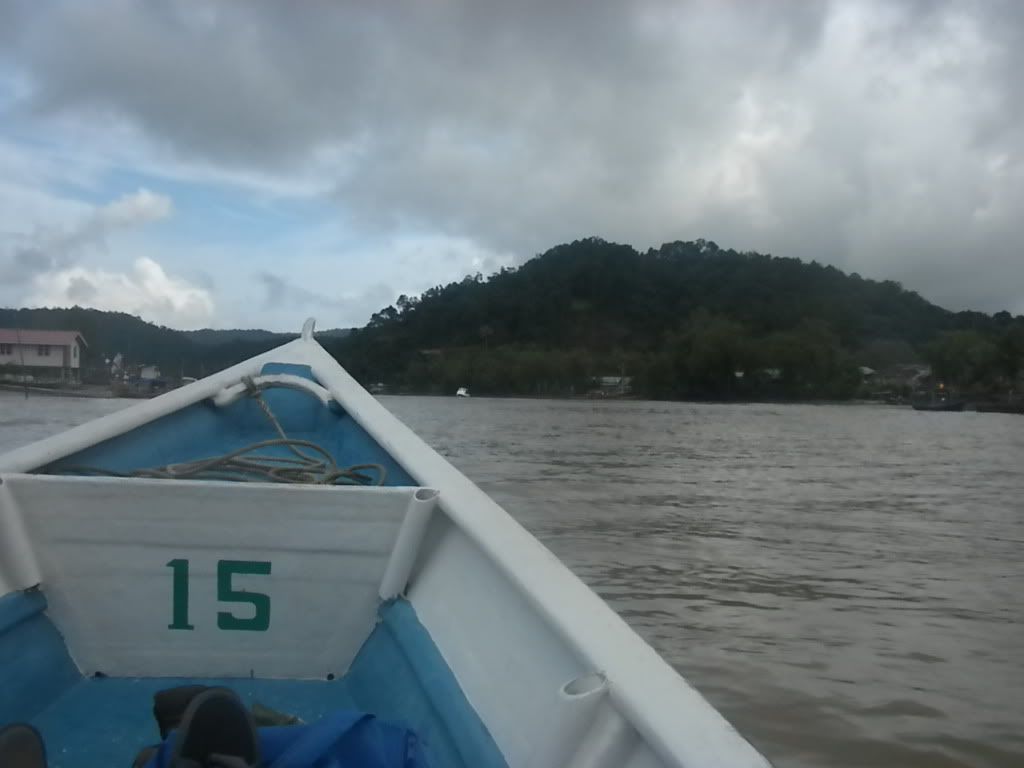
After about 40 minutes we arrived at the National Park, Francesca’s hands stiff from feverishly clenching the bench. Our first encounter with the Park’s wildlife soon followed. I spotted some mudskippers, which Francesca had never seen before. Next, Frida took us to our room, which was a smelly, dark and humid crib. A sign warned us to be careful of falling coconuts! Frida showed us a bright-green viper, which apparently always hung out in the same spot. We half suspected it to be made of plastic.
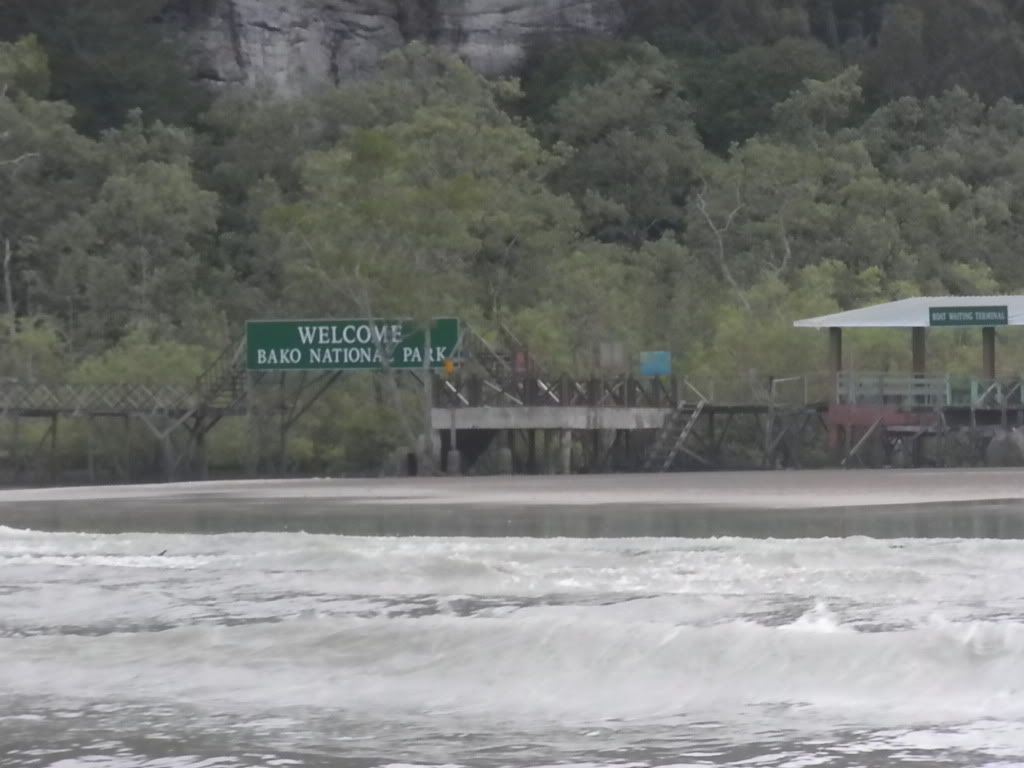
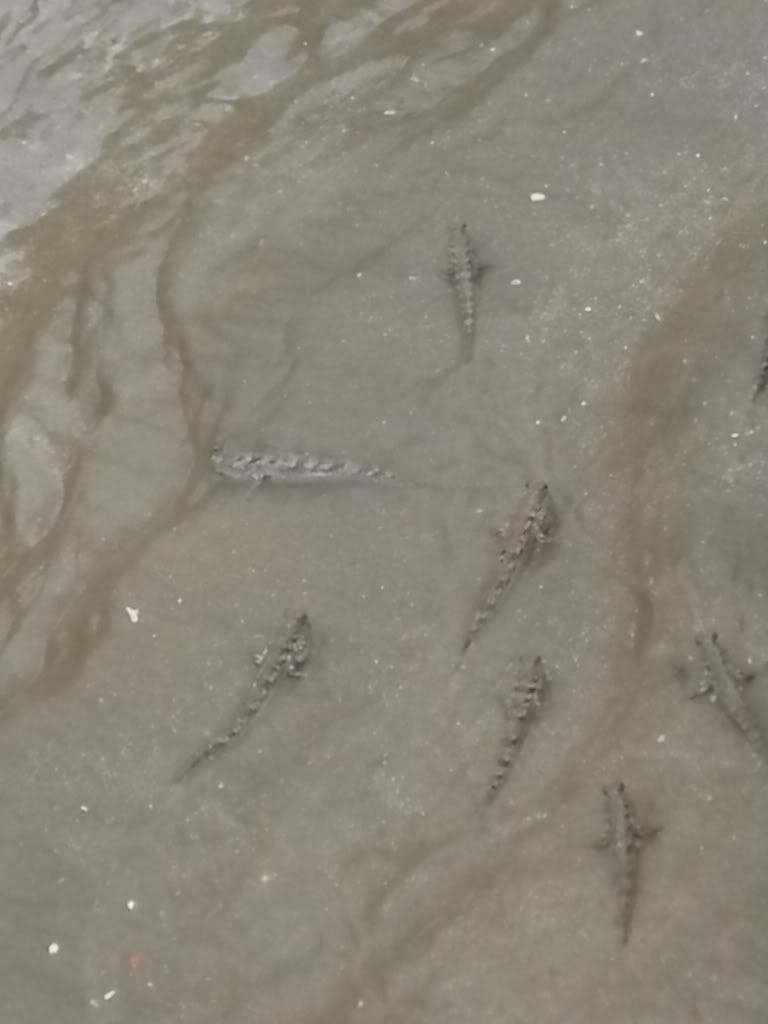
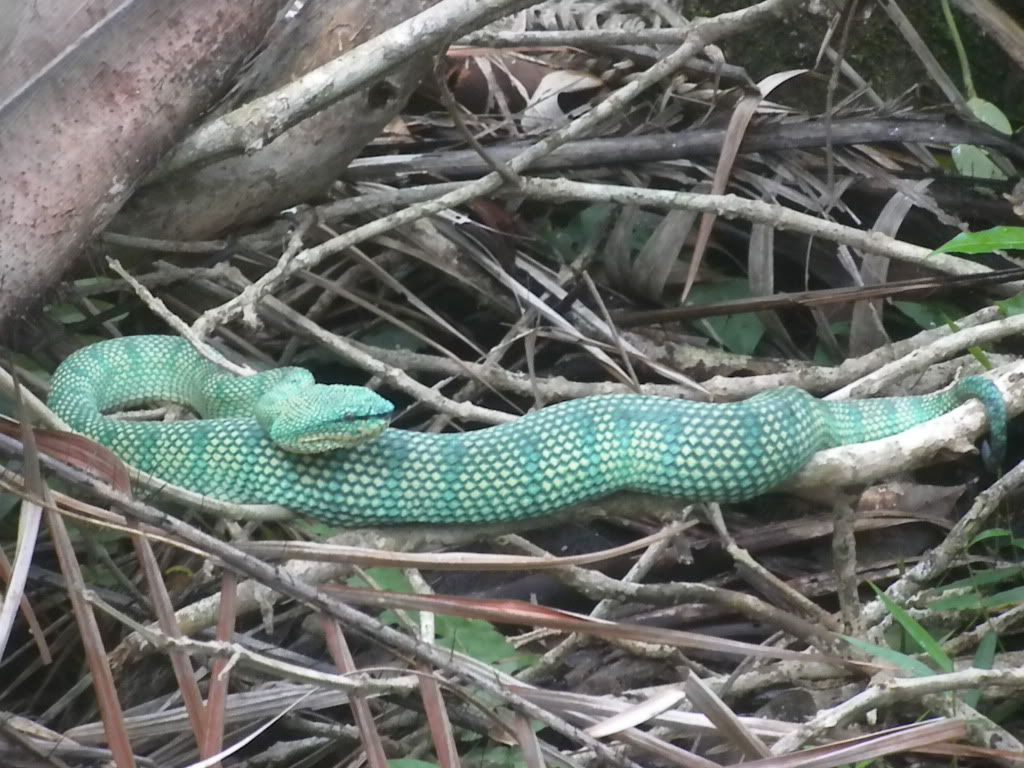
Frida let us put down our bags and get ready for some exploration of the Park. An hour later we were fully dressed, finally wearing our hiking boots again. They hadn’t seen the light of day for too long! We made a pit stop in the little supermarket, where Francesca saw more Oreo-rip-offs. Frida finally explained the sand balls left behind by crabs, which we had wondered about in Cape Tribulation. Apparently, the crabs hide their food in the balls! We also saw some hermit crabs, carrying their stolen house on their back. A giant wood-eating bug landed right next to us and posed for a perfect picture for me. Crossing a bridge over a small stream coming out of the rainforest, Frida led us through the mangrove forests, explaining their eco-system and importance to the coastline. She said that Bako and surroundings were protected from the tsunamis a few years ago, because they caught the massive waves and broke them. She also said the famed Proboscis Monkeys feed on the young leaves.
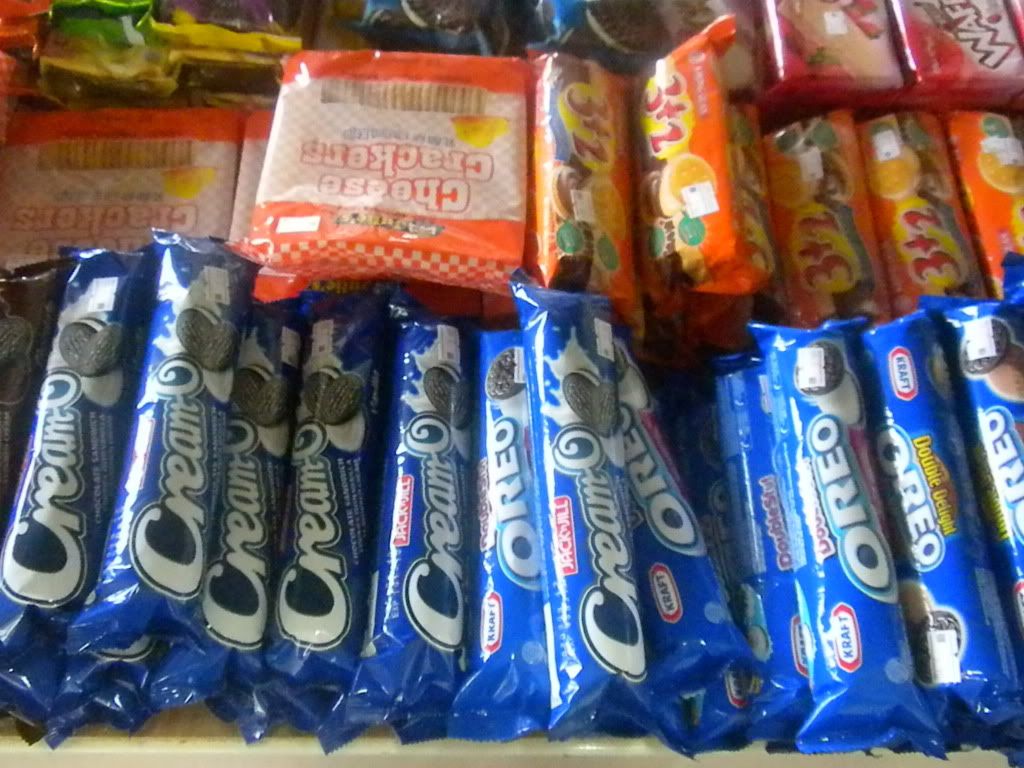
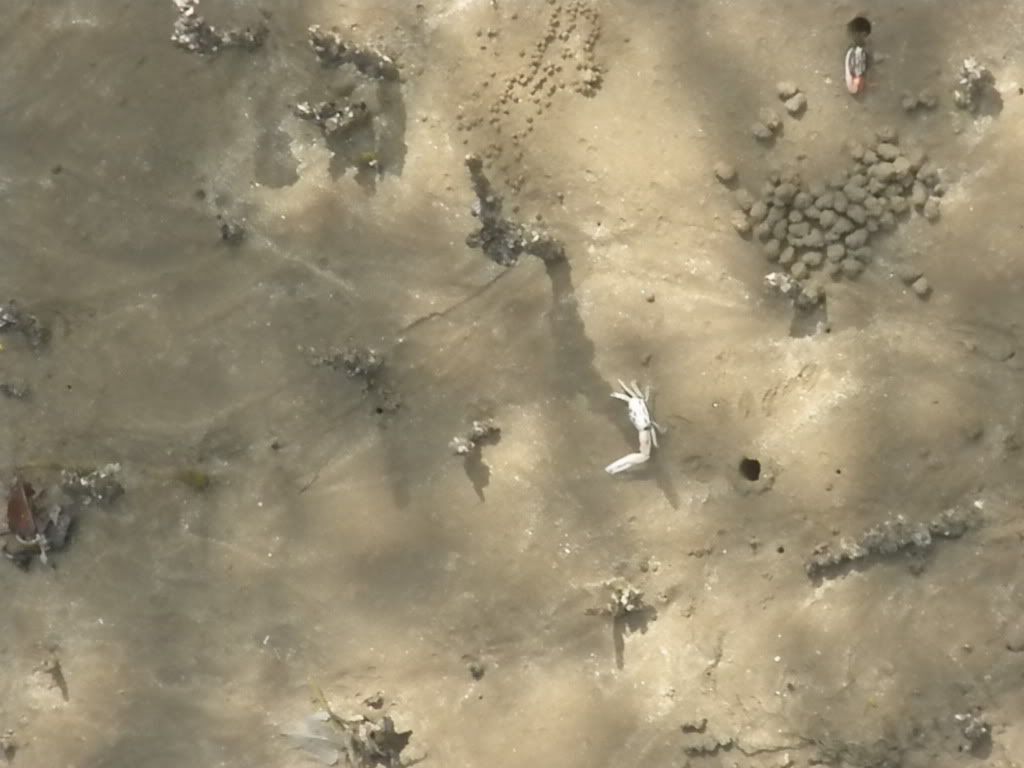

Right after that our walk started. Since it had rained the previous days the stones we had to step on were wet and slippery. Francesca does not like wet and slippery rocks! The first 30 minutes were all uphill, and got us both very sweaty. Reaching the top, we reached a plateau with some unusual plants: pitcher plants. They’re family of the Rafflesias, and looking at one, I could sort of tell why. Luckily, no bad smell! In fact, the monkeys drink the dew and rainwater collected by the pitcher. Around 11:30 AM we reached our destination: a beach. Francesca had developed a bit of a headache, climbing and descending in the hot sun, so we sat down for a while. Frida said we could go for a swim, but we were both content staying as wet as we were from all the sweat. Besides, Francesca was quite desperate to see her ‘nose monkeys.’ Knowing that we’d have a good chance of catching them having lunch near the mangroves at the beginning of the walk we decided to turn around, just taking some pictures of the beach.
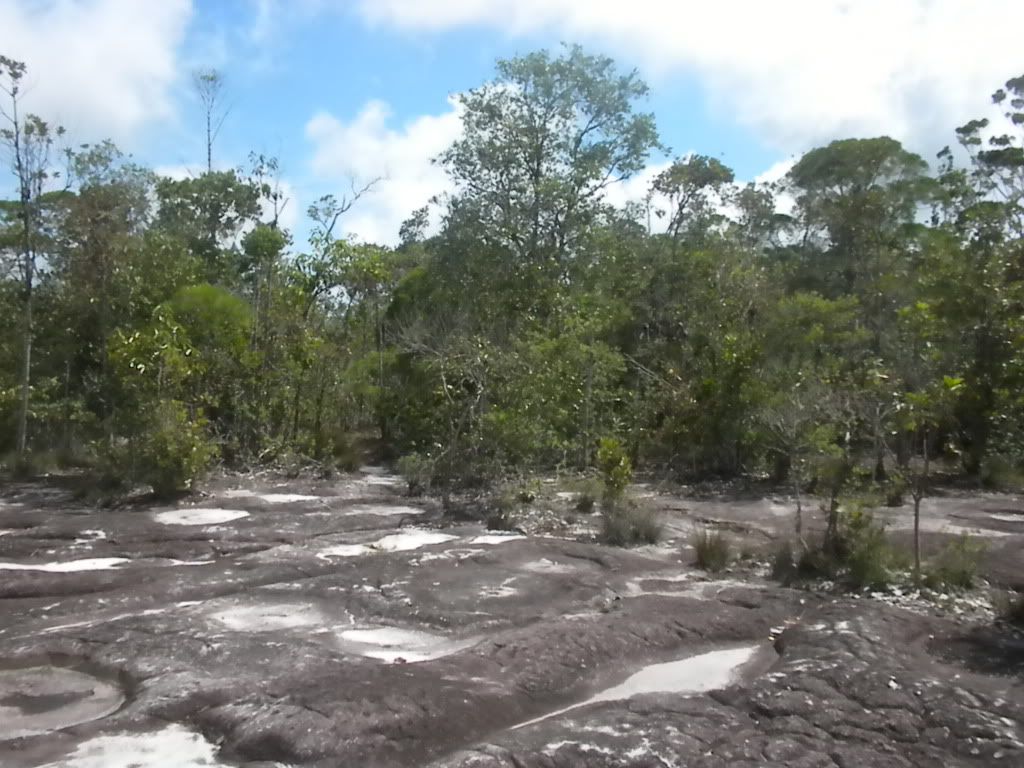
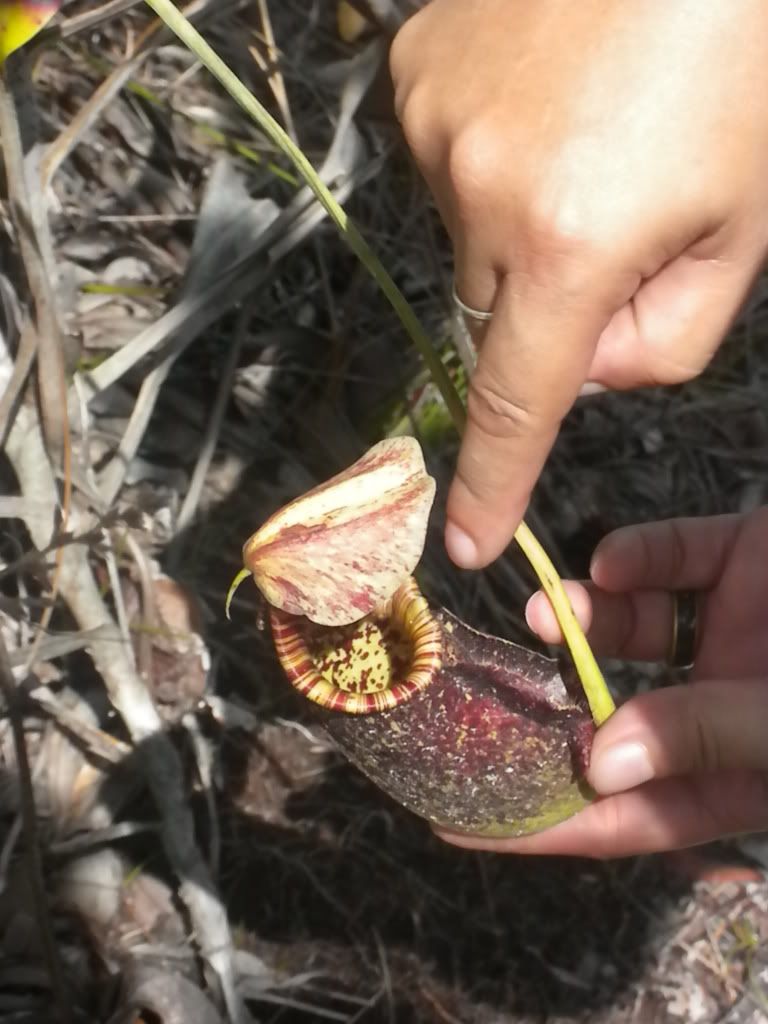


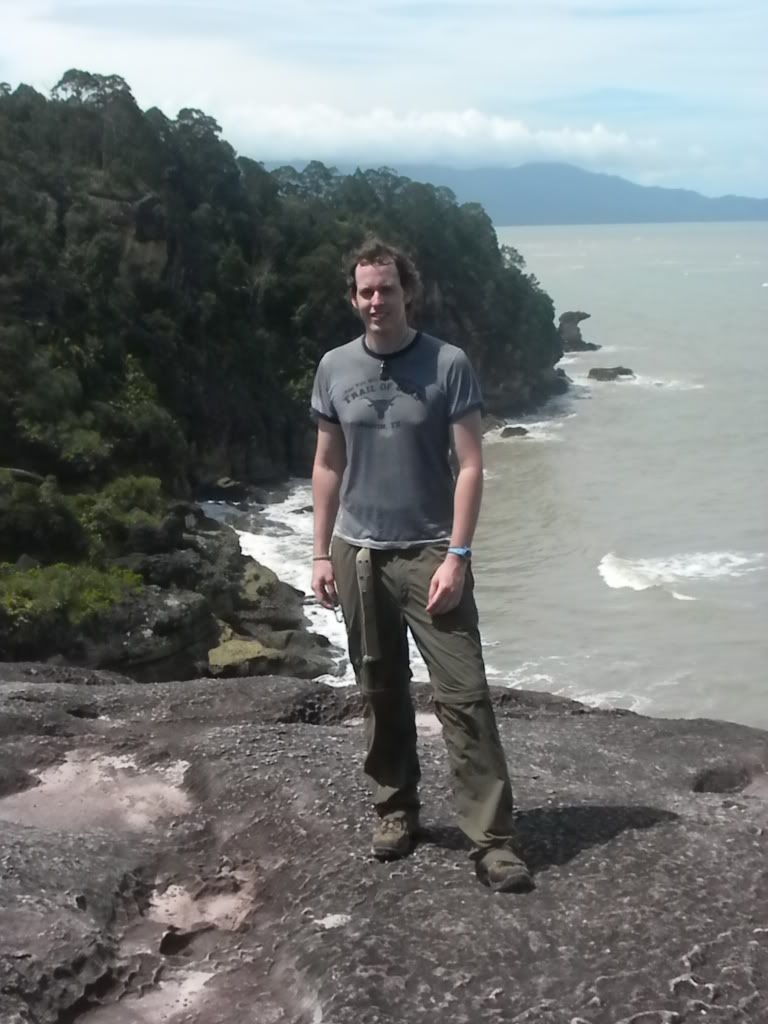
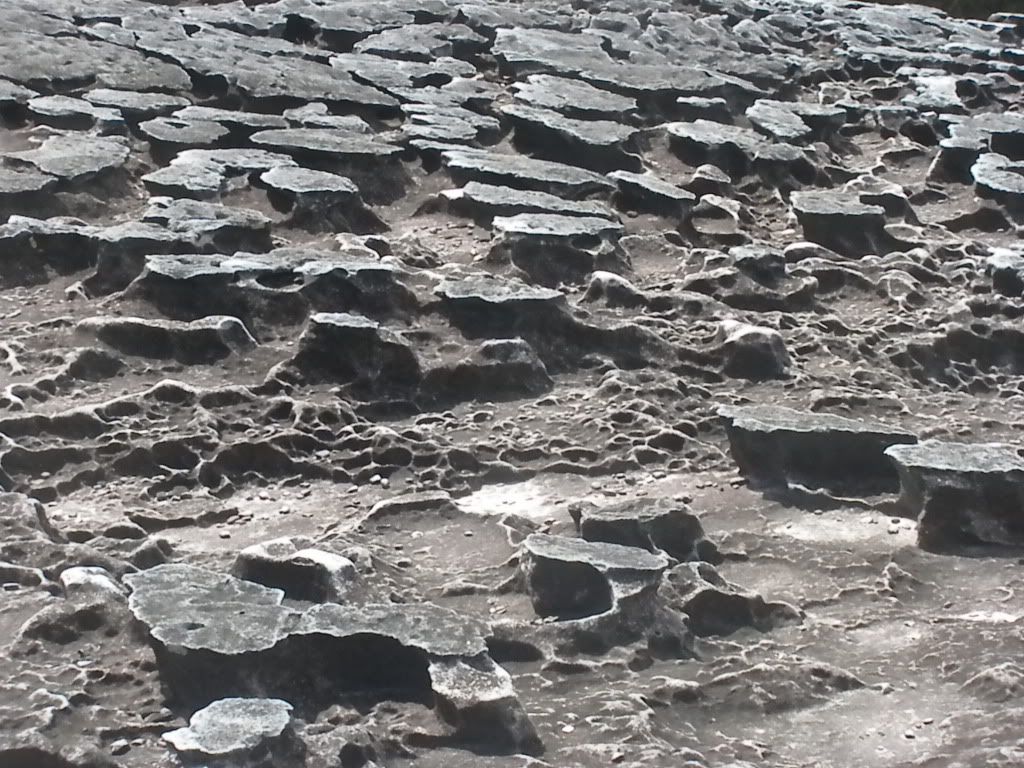
Francesca and I spotted quite a lot of junk (mainly bottles) along the way, and decided to clean up a little. I had an empty bag in our daypack, which served as a garbage bag. Frida tied it to her shoulder bag, and off we went. As we retraced our own footsteps, more and more bottles were added to the collection. About halfway through we saw some monkeys rustling in the treetops. Before we knew it the leader had given the order to ‘attack’ and Frida was the target! Luckily, she realized they were after the plastic bag: highly valued by the macaques as they often contain snacks. She managed to undo the knot and drop the bag, running back to us. She told us to stay calm and not look in the monkeys’ eyes, as this would provoke them. True enough, even though they passed us by no more than a few feet we were completely ignored. One monkey stayed behind, examining the bag, but eventually left as it discovered nothing edible.

Frida was visibly shaken by the encounter, also announcing something similar had once happened to her and she’d nearly been bitten by a macaque. Their teeth look quite ferocious; a bite could lead to gaping wounds and nasty infections. The rest of the walk was a little less adventurous, as we took it easy making sure we wouldn’t slip and fall. When we walked out of the forest we were greeted by our first surprise: a troop of Silvered Leaf Monkeys! They have “gray tips on dark brown or black fur, although the groin and ventral side of the tail are yellowish in color.” Apparently, they’re also quite rare and we were lucky to see them! They were no more than 10 feet away from us, and didn’t seem to mind us that much. One was even staring right at the camera! Francesca also spotted a little orange fur ball. One of the monkeys had a little baby with it, which are apparently always bright orange!
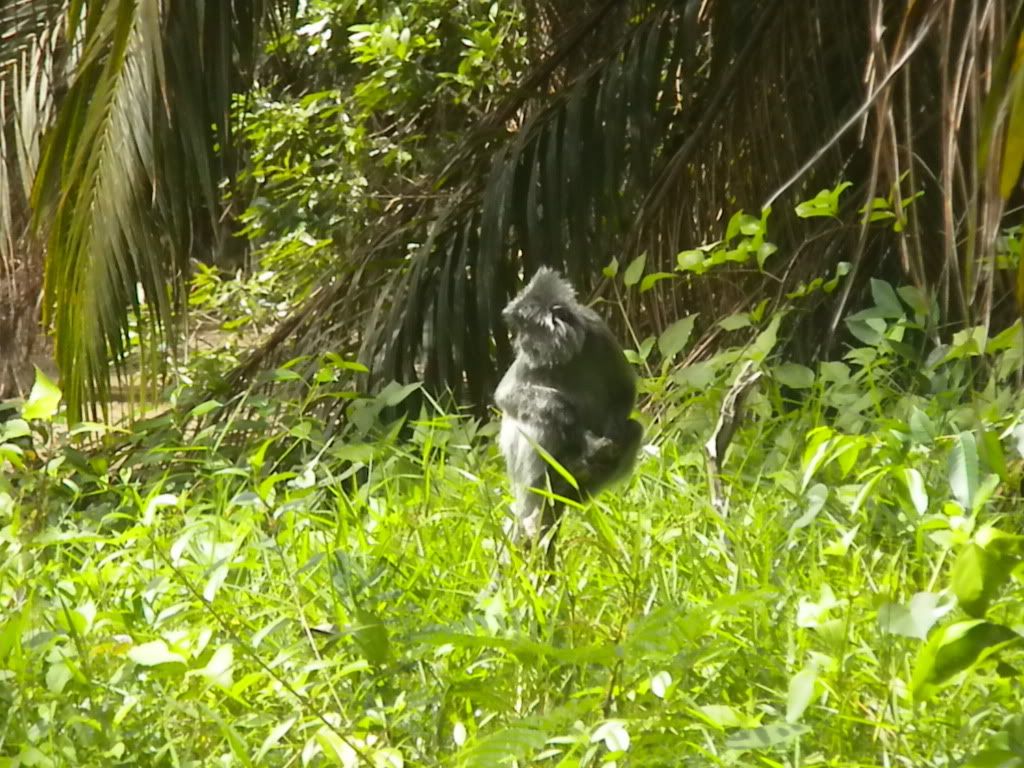
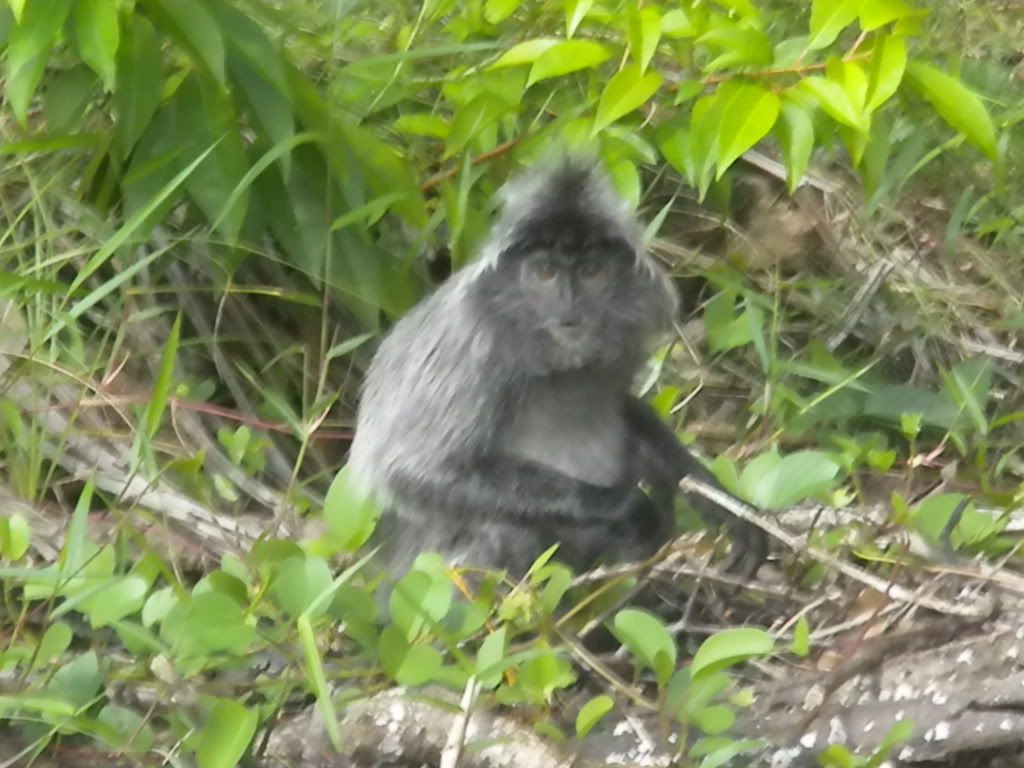
The Silvered Leaf Monkeys were cool, but not the main goal for the day. Frida led us a little further on the boardwalk, towards the sea. There, we spotted Francesca’s favorite monkey: the Proboscis Monkey. The troop had apparently just finished eating, as it was moving back towards the rainforest. I tried to catch up with them, but they’re shy and not too keen on humans. Walking on the wet sand, I tried to stay invisible, but the monkeys were aware of my presence and kept moving. I did manage to get a few good pictures as they sat in the trees, where they were less bothered by my presence.
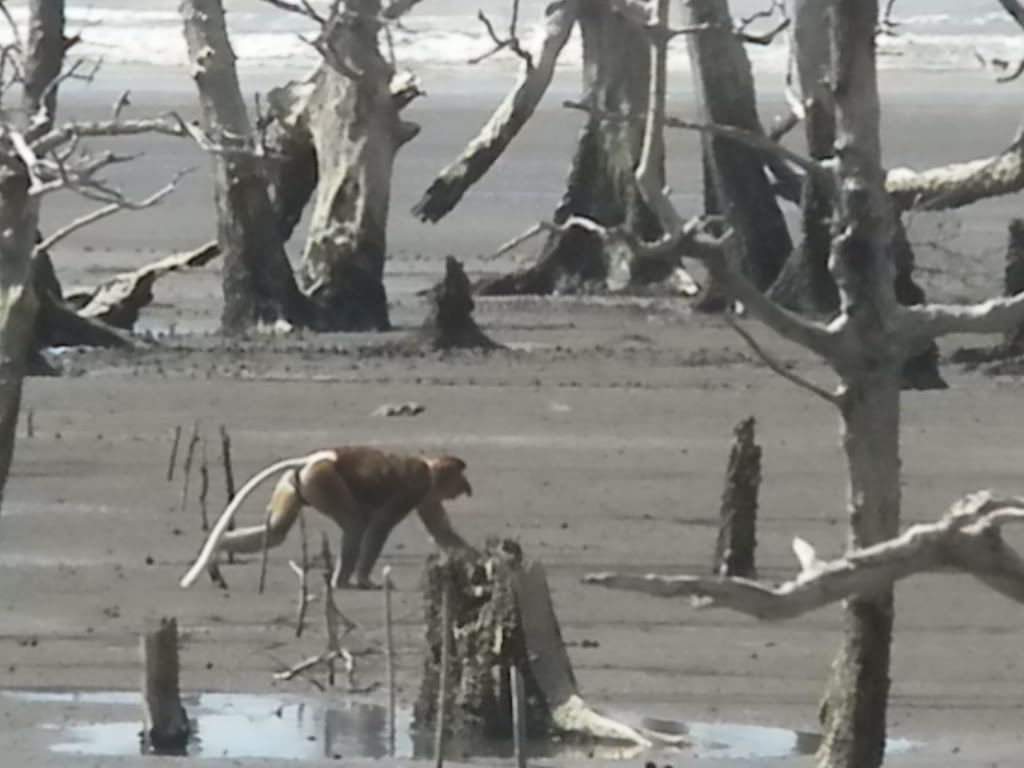
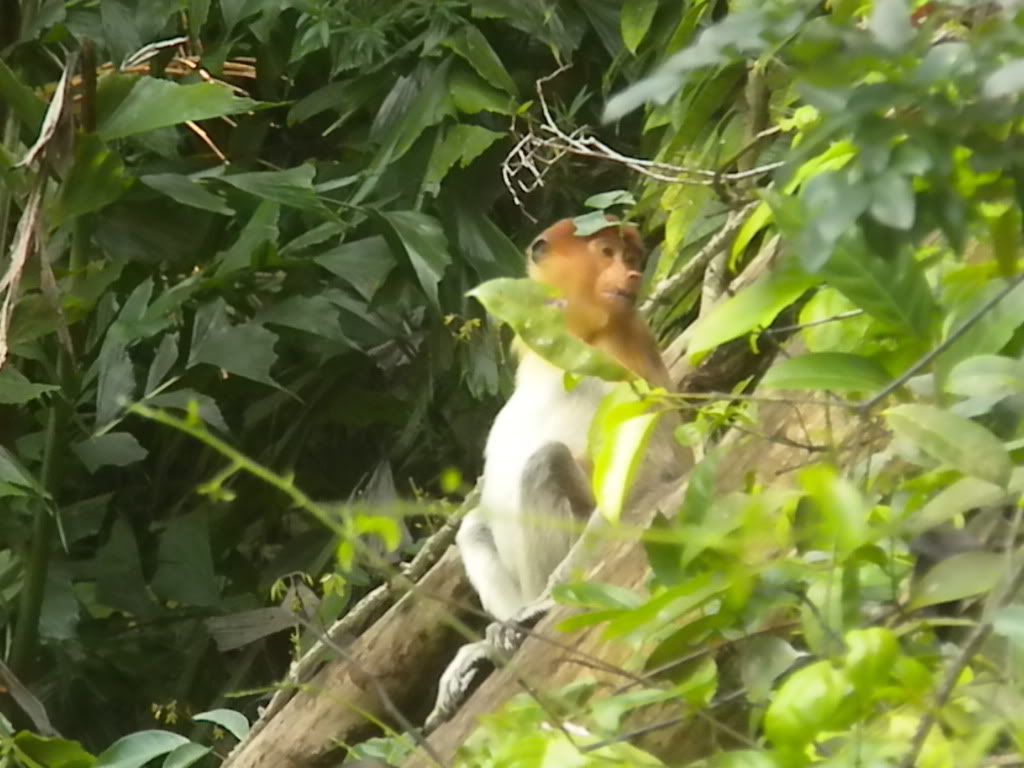
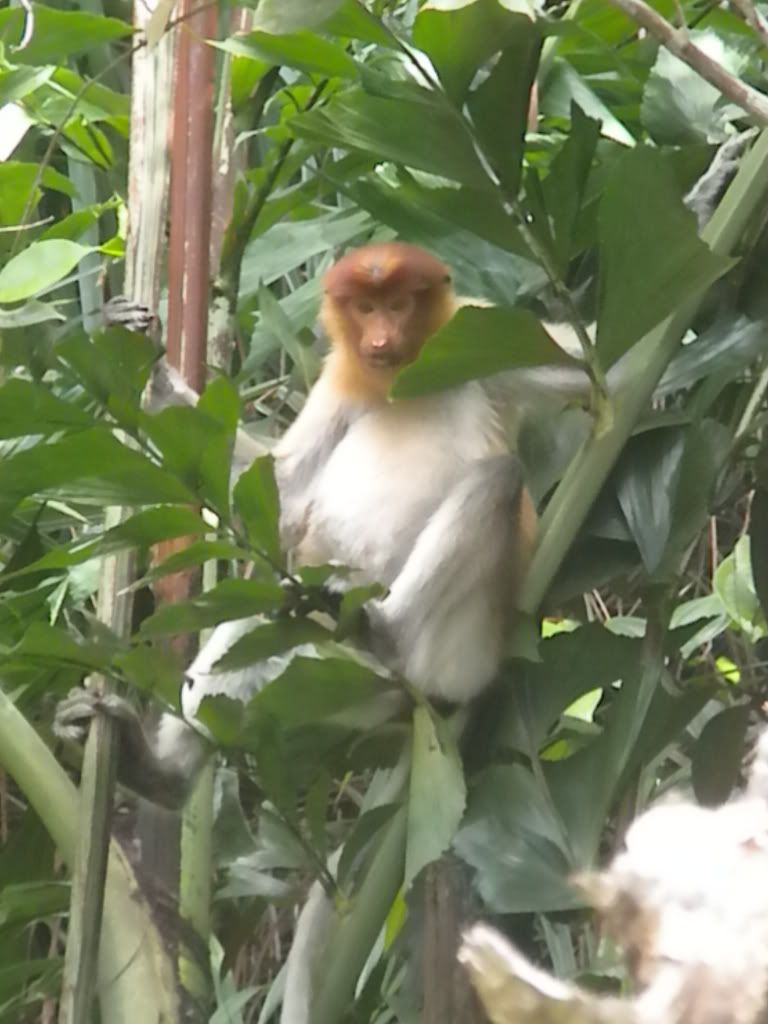
I knew Francesca and Frida were still waiting on the platform, so I returned to them, excited to show them my photos. However, they’d been eager to see me return as there were some stragglers right in front of them. And to make things better: one of them was a male! To explain a little about Proboscis Monkeys, here’s our reporter in the field Wiki Pedia. Wiki, what can you tell us?
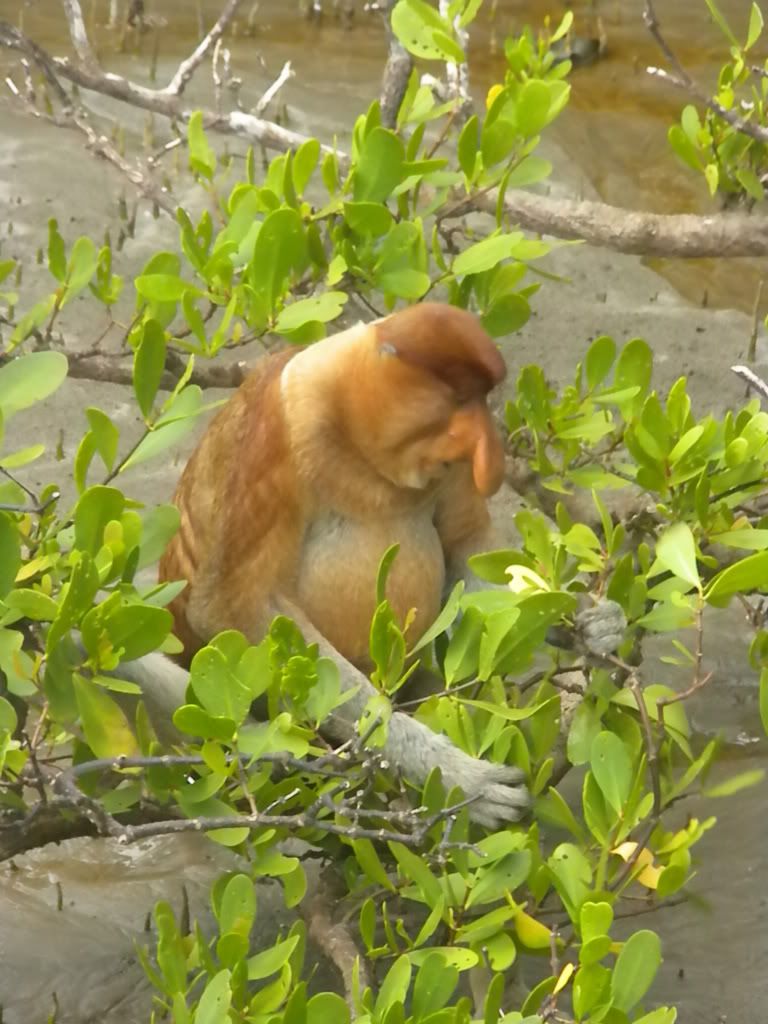
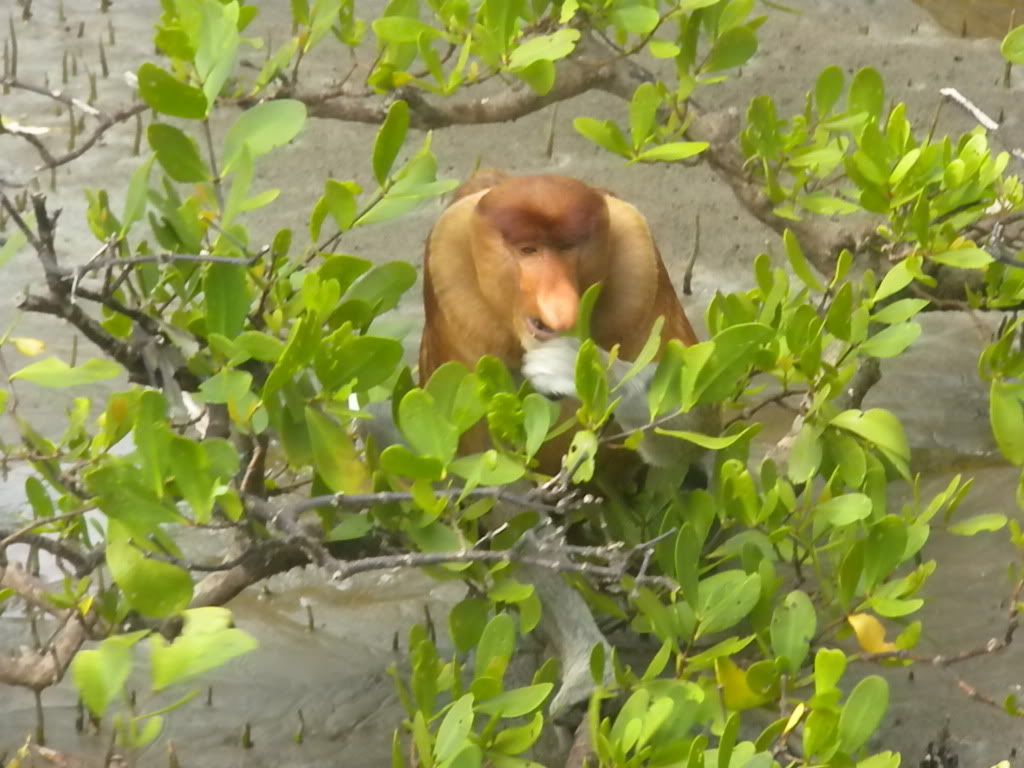
“Well, Henk and Francesca and all those readers back at home, Proboscis Monkeys are also known as Long-nosed Monkeys. Their fur is a reddish-brown. A distinctive trait of this monkey is the male's large protruding nose, from which it takes its name. The big nose is thought to be used to attract females and is a characteristic of the males, reaching up to 7 inches in length. The females also have big noses compared to other monkey species, but not as big as the males. Besides attracting mates, the nose serves as a resonating chamber, amplifying their warning calls. When the animal becomes agitated its nose swells with blood, making warning calls louder and more intense.
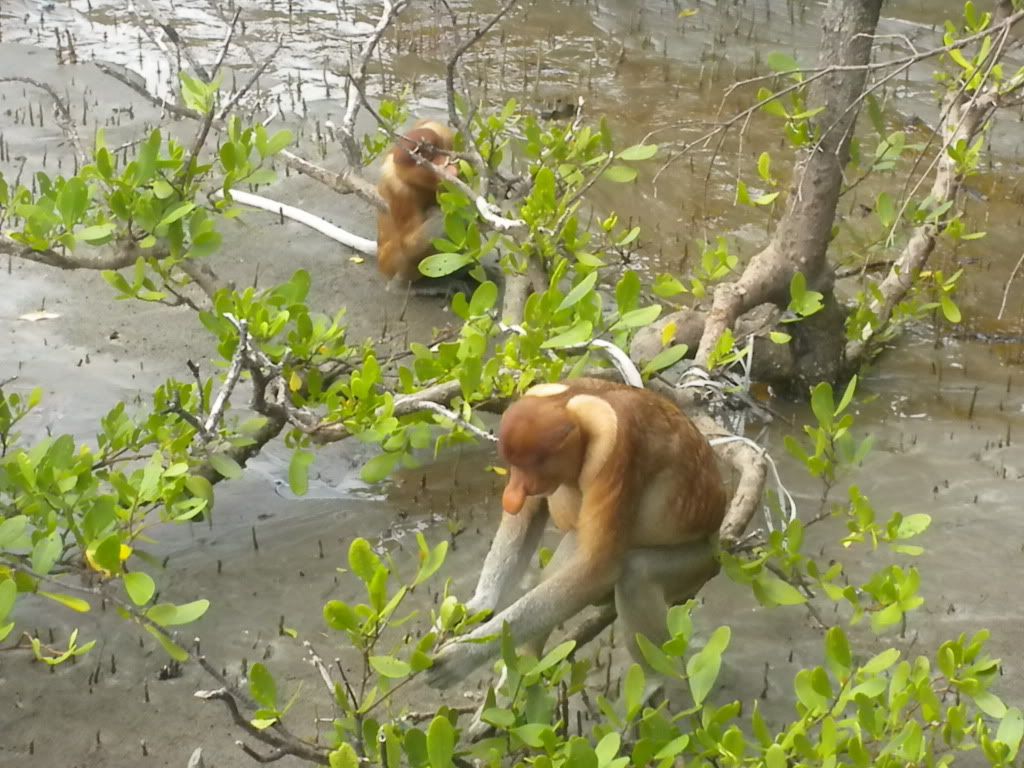
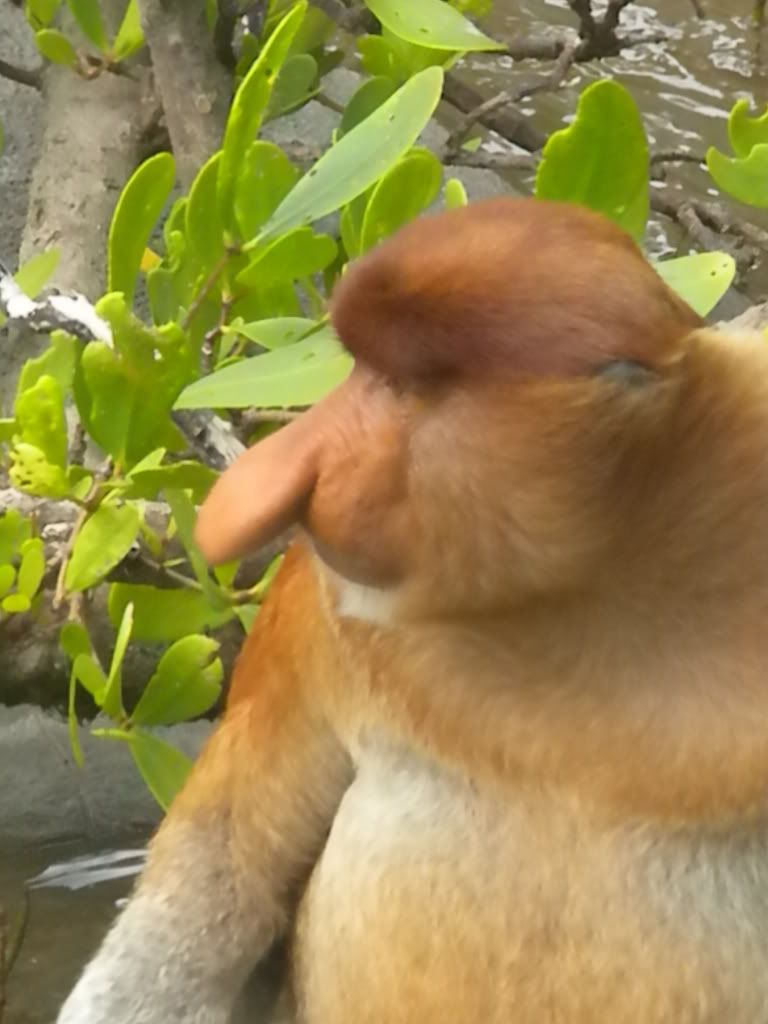
The monkey also has a large belly, a result of its diet. Its digestive system is divided into compartments, with bacteria that digest cellulose and neutralize toxins from certain leaves. This lets the monkey eat leaves and remain in the forest canopy. The contents of their stomach weigh in at about a quarter of their whole body. A side-effect of this unique digestive system is that it is unable to digest ripe fruit, unlike most other simians. The diet consists mainly of seeds, leaves, mangrove shoots and unripe fruit.
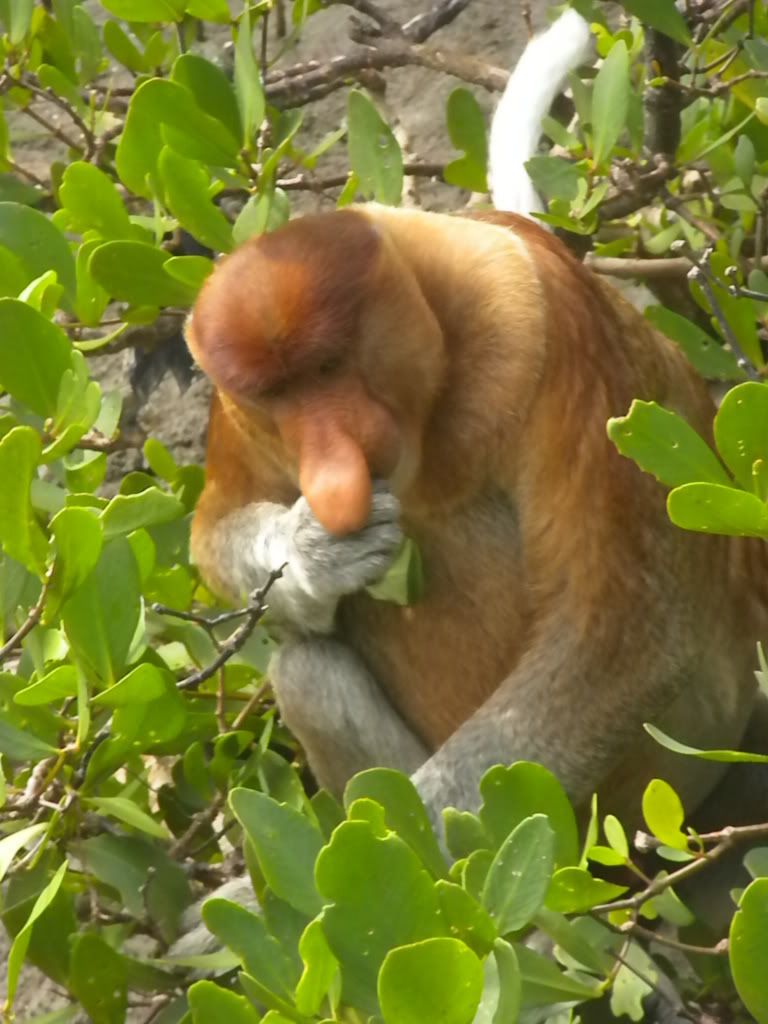
The Proboscis Monkey climbs well. It is also a proficient swimmer, often swimming from island to island, and has been picked up by fishing boats in open ocean a mile from shore. While wading, the monkey uses an upright posture, with the females carrying infants on their hip. Troops have been filmed continuing to walk upright, in single file, along forest trails when they emerge on land, the only non-human mammal, with the exception of gibbons and giant pangolins, known to use this form of locomotion for any length of time.
Also, an Indonesian nickname is 'monyet belanda', meaning 'Dutch monkey' or 'Orang Belanda', the Indonesian word for 'Dutchman', as Indonesians noticed the Dutch colonizers often also had a large belly and nose." Do you feel insulted or honored looking at these pictures, Dutchies?
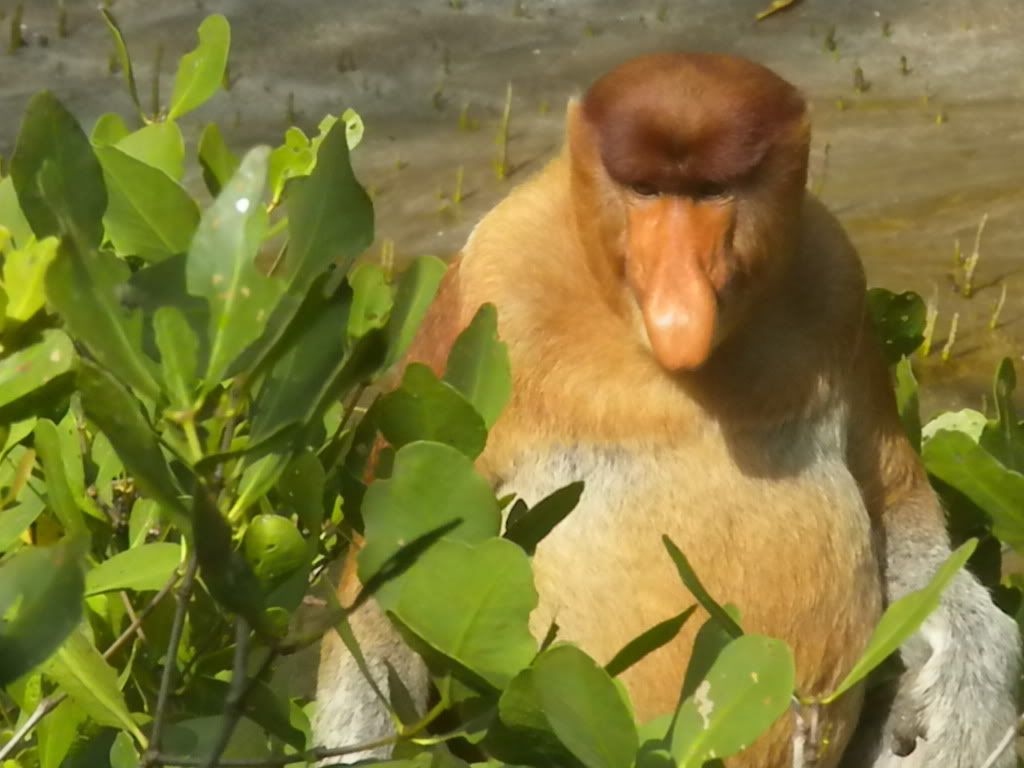
Apparently, this male wasn’t quite done feeding. He led his little troop to another set of fresh, young leaves and sat down. These mangroves were right next to another platform. Hoping to get some better pictures, I quietly snuck towards this platform. The monkeys saw me, but didn’t care! I got to take so many good pictures, and Francesca was so excited to see the ‘nose monkeys’ up close. It was also the perfect time to bring out Monkey and Puppy once again. They finally got to see some daylight and joined the photo shoot. We spent a good hour watching the male and a few females, and finally they seemed full. Perfect, because we were quite filthy and hungry. As the monkeys left for the forest, we were extremely happy to have seen so much wildlife.
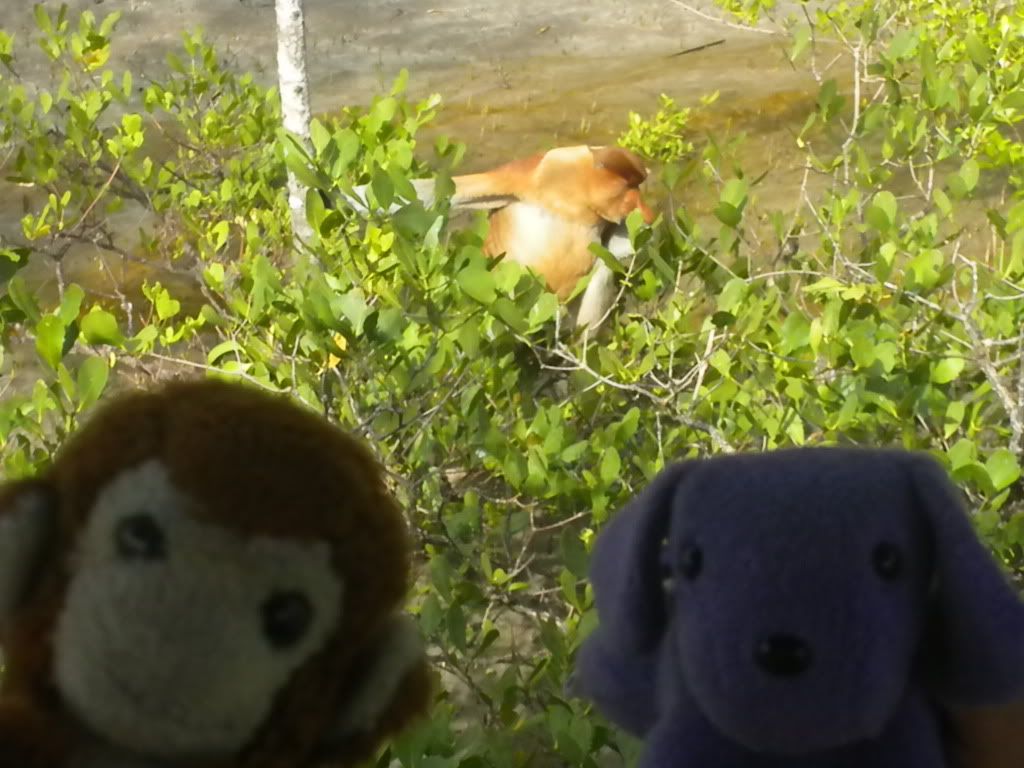
Francesca still had a bit of a headache, so I decided our humid room would not help her get any better. I made sure we got to switch to a nicer, albeit slightly more expensive chalet, where it was nice and cool. Whilst she slept a little, I got everything ready for a shower. After the shower we joined Frida for dinner. A nice buffet with a variety of local food waited for us and the other visitors. After the long day we made sure we filled our bellies up to the size of the Proboscis Monkeys!
Our day wasn’t quite over yet, as Frida had also informed us of a night walk. A chance to see some of the nocturnal fauna during an easy, hour-long walk. Perfect!
We gathered outside reception around 8PM, joined by only 3 other people. We borrowed some flashlights from one of the guides and headed off into the jungle. The same snake we saw earlier that day was still in the same spot. Much more interesting were huge stick insects the guide managed to find. He also showed us a sleeping Kingfisher, a large spider, some catfish, a little lizard and several tiny frogs. The highlights of the walk were the slightly bigger mammals he spotted: we saw two mousedeer! They scurried around in the bushes right in front of us. Whenever they looked at the flashlights, two bright yellow dots popped up. Our second big ‘catch’ was a civet. It was hunting high up in the trees, but again we could see its eyes.
As we walked back Francesca spotted a strange thing: a crab hiding in a tree trunk. It didn’t seem too pleased with our presence, so we left it alone. Once back at our chalet we promptly fell asleep. During the night a major thunderstorm hit Bako National Park. The strikes were getting pretty close, and every time it flashed the ground shook. Francesca found it pretty scary, predicting apocalyptic threats outside. I taught her how to tell whether the storm was getting closer, or moving away. Count the seconds between the flash and the thunder, and divide this by three. Every three seconds is one kilometer. It seemed to keep her busy, and she could tell it was moving away.
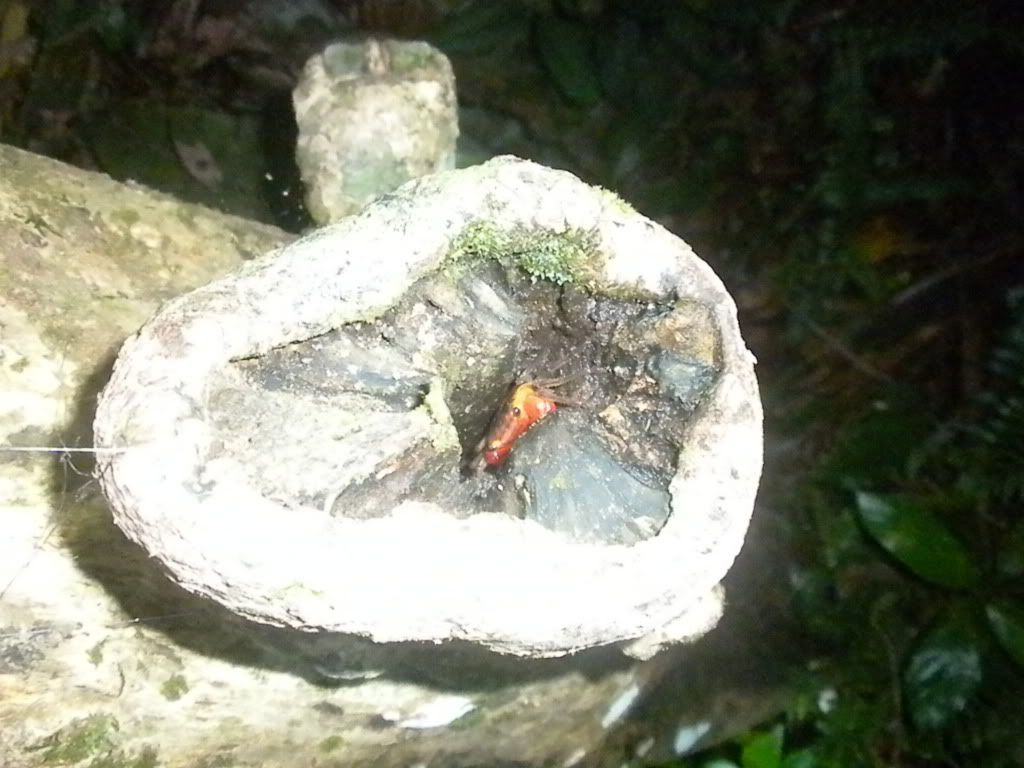
We fell asleep again, only to wake up at 7AM. A little surprise was waiting outside when we wanted to go to breakfast: a family of wild pigs lived near the chalets, and the dad just walked right by us. The weather was still pretty bad, so our planned hike fell through. After breakfast (again very tasty!) we tried again, with ponchos on, but none of the shorter hikes were available due to the bad weather. Francesca and I walked around on the beach for an hour, looking for some Proboscis Monkeys, finding none. They were probably as deterred by the rain as we were… We asked Frida to take us back a little sooner, giving us time to recharge for the following two days. She called our boatman, but jumped in a different boat as we waded a good 50 meters into the sea to get close to the boats.

We got back to Tracks in the late afternoon and relaxed for the remainder of the day. Francesca could not get up anymore, so I went out to get dinner. I found a nice restaurant called ‘The Junk,’ where they had pizzas and garlic bread. I picked up a Margherita Pizza and a large box of garlic bread to share. The pizza was in good hands with Francesca, as she devoured most of the slices whilst I had a few as well, along with some garlic bread. We went to sleep early, making sure we were well rested for more adventures the next two days.
On the morning of the 24th of December Francesca were picked up early again, this time by David. He would first take us to Semonggoh Wildlife Rehabilitation Centre. Their website says: “Set up in 1975, this 740-hectare of virgin forest is home to orang utans, honey bears, hornbills, porcupines, storks, barking deer and monkeys. Most of these animals were rescued from captivity and are being rehabilitated here in their natural surroundings.” Obviously, we went there to see orang utans! A short thirty minute drive later we were at the entrance to the park. David drove us towards the main platform, but we were halted by a group of people and some rangers coming towards us. Apparently, the orang utans were getting closer to us!
To explain a little about our chances of seeing the rare ‘men of the forest:’ (orang means forest; utan means men in Bahasa) it was fruit season, which means the orang utans don’t need to come to the platforms for food. Furthermore, this was proven by the statement that they hadn’t been seen the last two days. When we saw an arm and a leg of a young orang utan in the distance I thought that would be all of it. Especially since the people around us had no idea how to be quiet, regardless of all the comments from the rangers. One of the rangers saw we were genuinely interested and tipped us to go to another platform. He thought they’d go there next, so we’d have a good spot. And true enough, we saw more leaves rustling in the distance! Not long after the young orang utan came in full view. Her name was Selina, and she carefully worked her way to the feeding platform, where some ripe coconuts and other fruits were lined up for her.
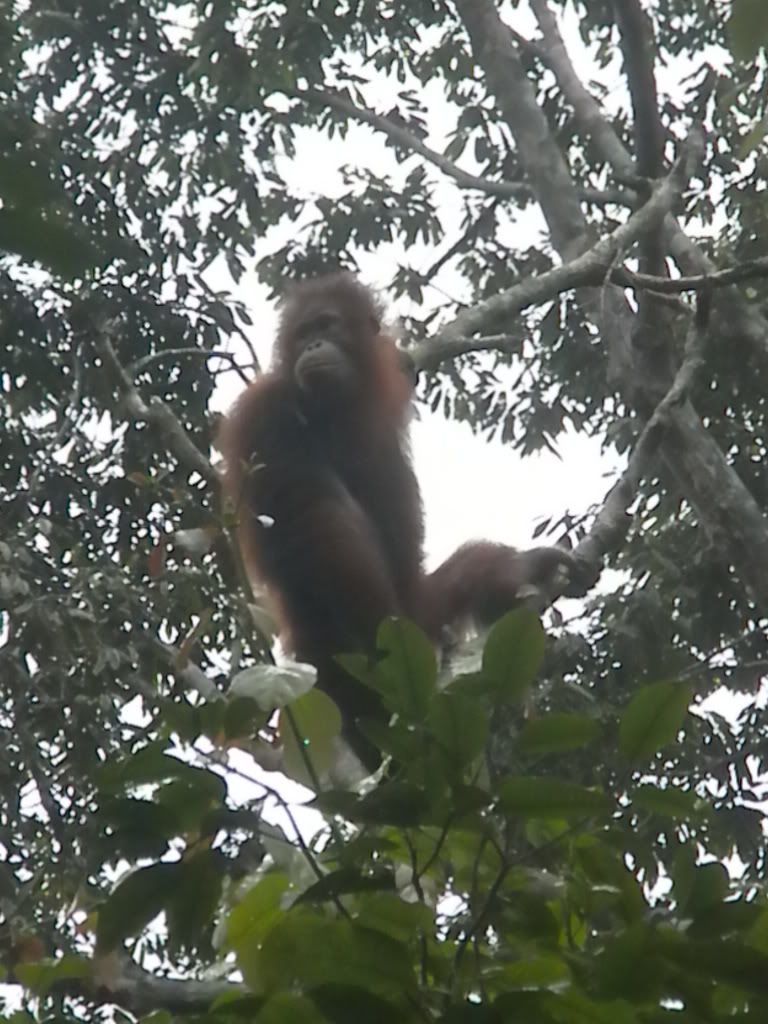
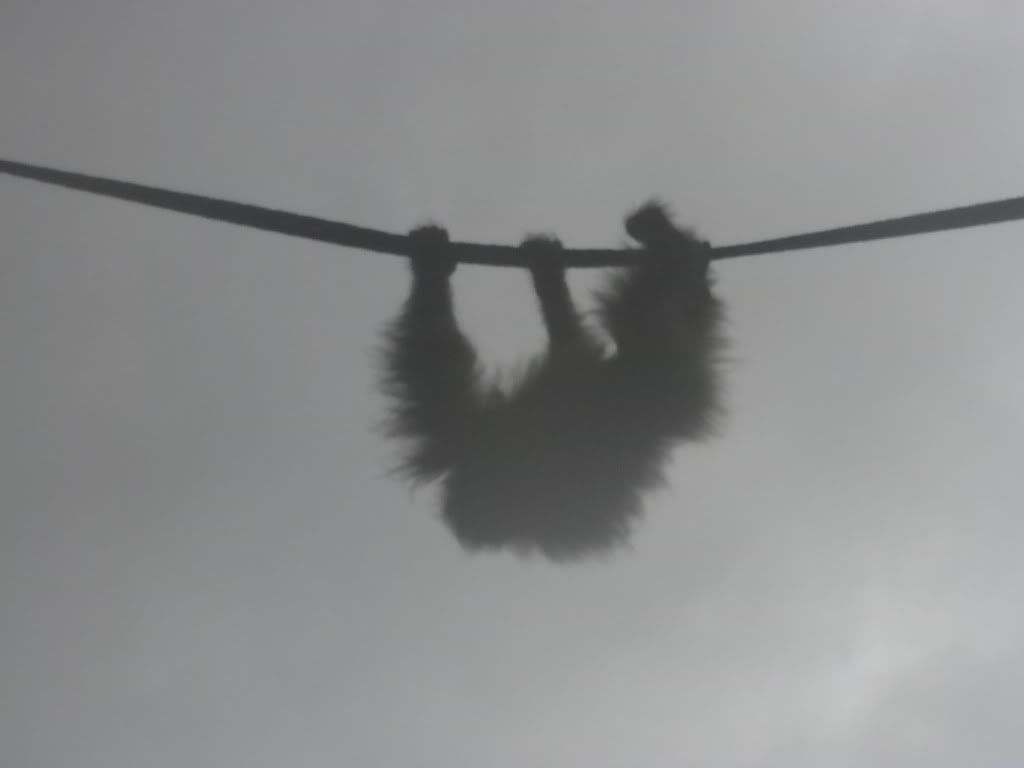
First, one of the rangers gave her a bottle of milk, which she played with for a while. Losing interest in the drink she dropped the bottle and went for a coconut. Her first attempt failed as she dropped the coconut on her way to a safe spot. One ranger put it back and she went after it again. This time her attempt succeeded and off she went with her snack.

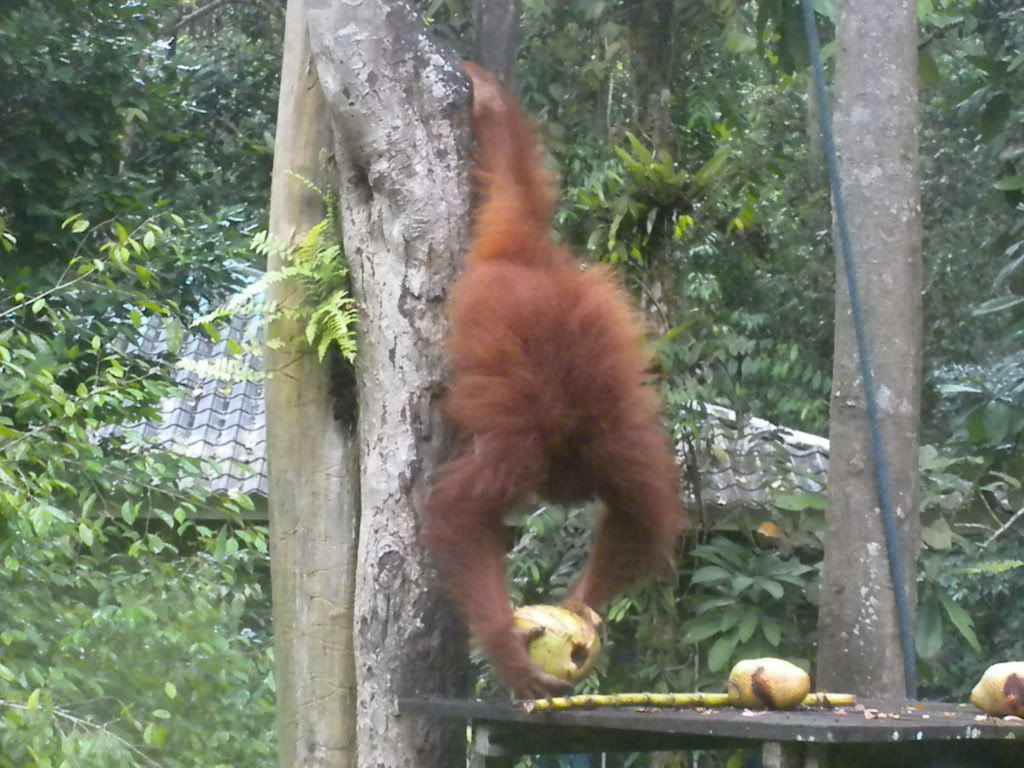
One ranger explained to me she was still young, and her mother Delima with her new baby, couldn’t be too far away. Indeed, she stayed a little further away, but we managed to spot her and because the rangers were feeding her we had plenty of time to get some pictures. Around 10 AM David told us we had to move again, so we said goodbye to our new friends and left for Annah Rais.

An hour later David dropped us off with our new family for Christmas. We stepped onto the slippery bamboo and were greeted by some locals that handed out ‘tuak,’ a local rice wine. It tasted pretty good, but because we were still going to hike we didn’t have too much. As David guided us through the village to our homestay we saw the village was in full preparation for Christmas. People were putting up decorations, preparing food and loads of yet-to-be-killed chickens were all around us. David introduced us to ‘Uncle Edward,’ our host. Uncle Edward showed us our comfortable room and asked us to come down when we were ready to discuss the day. We walked around the village for half an hour, meeting some locals chopping up bamboo. We wondered what they were doing, so we asked. One of the men explained they were making sharp pikes, to be used for climbing Durian trees. Very interesting! When we returned to our home a little later Uncle Edward was sitting outside ready to share his stories.
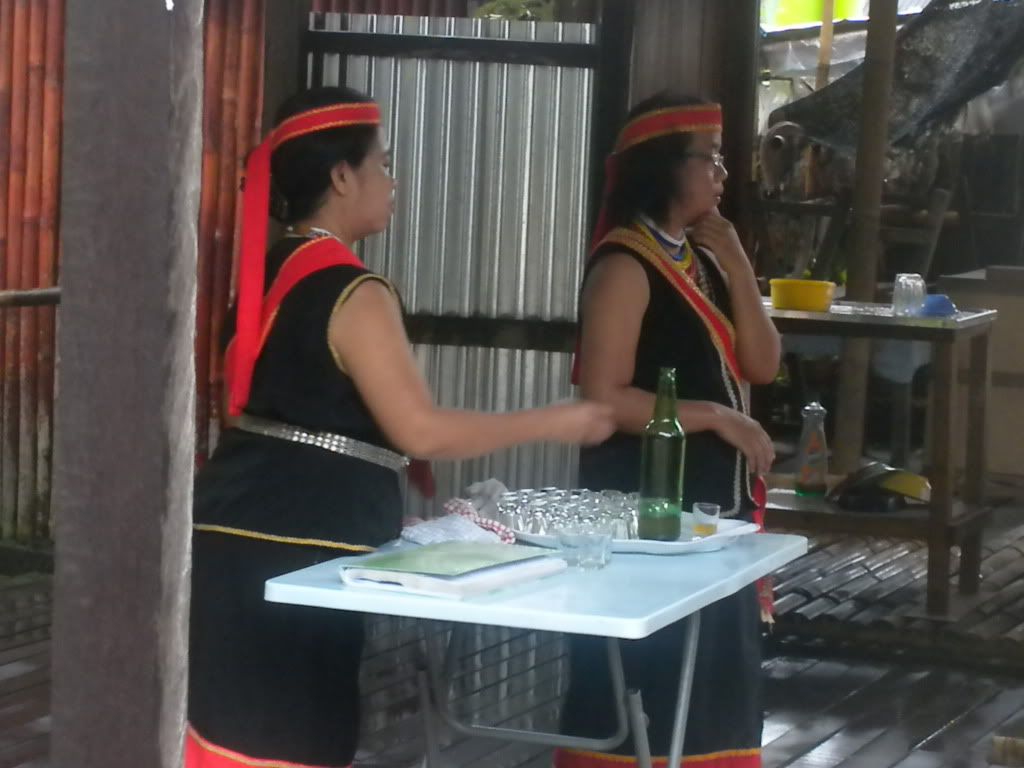
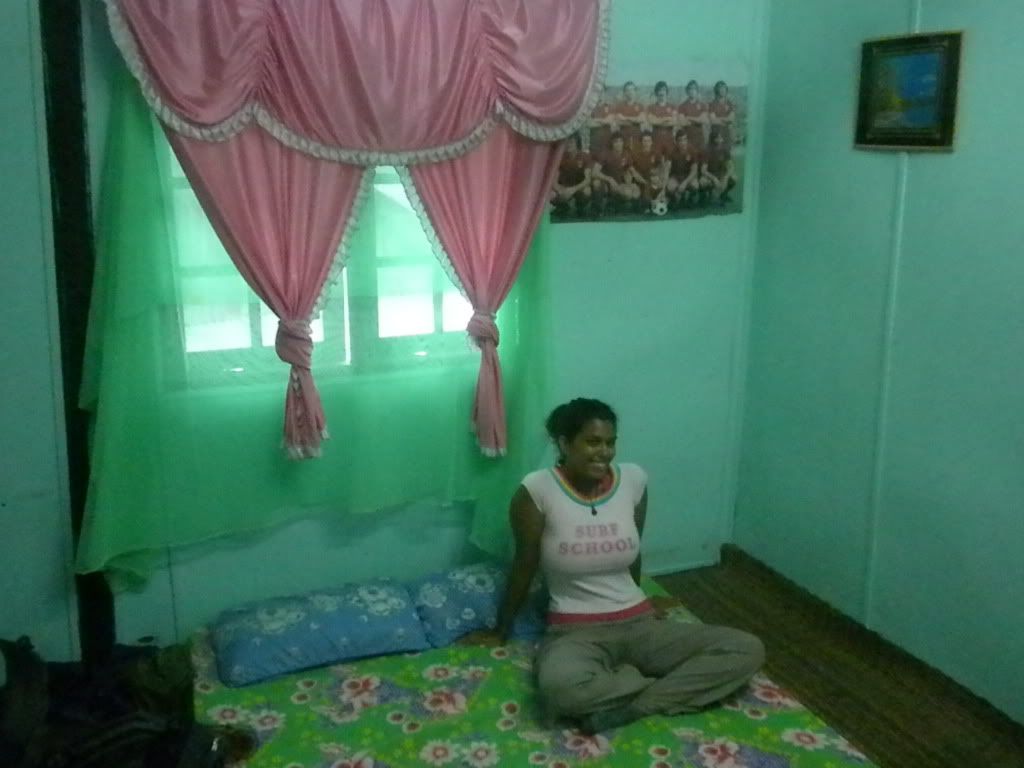
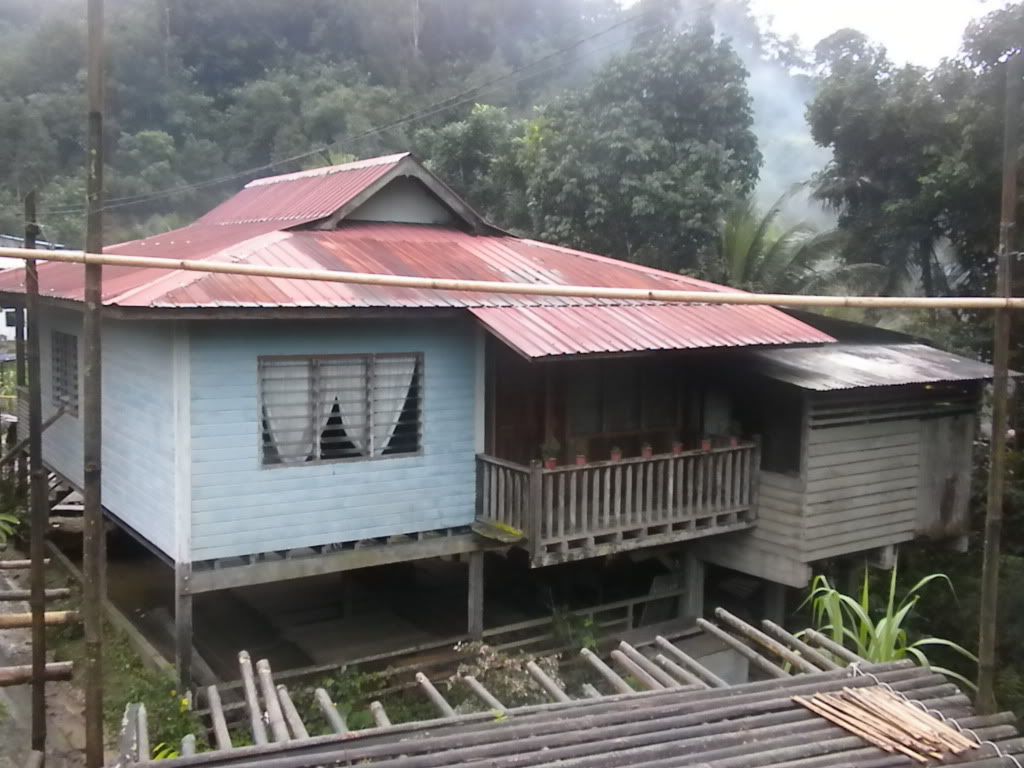
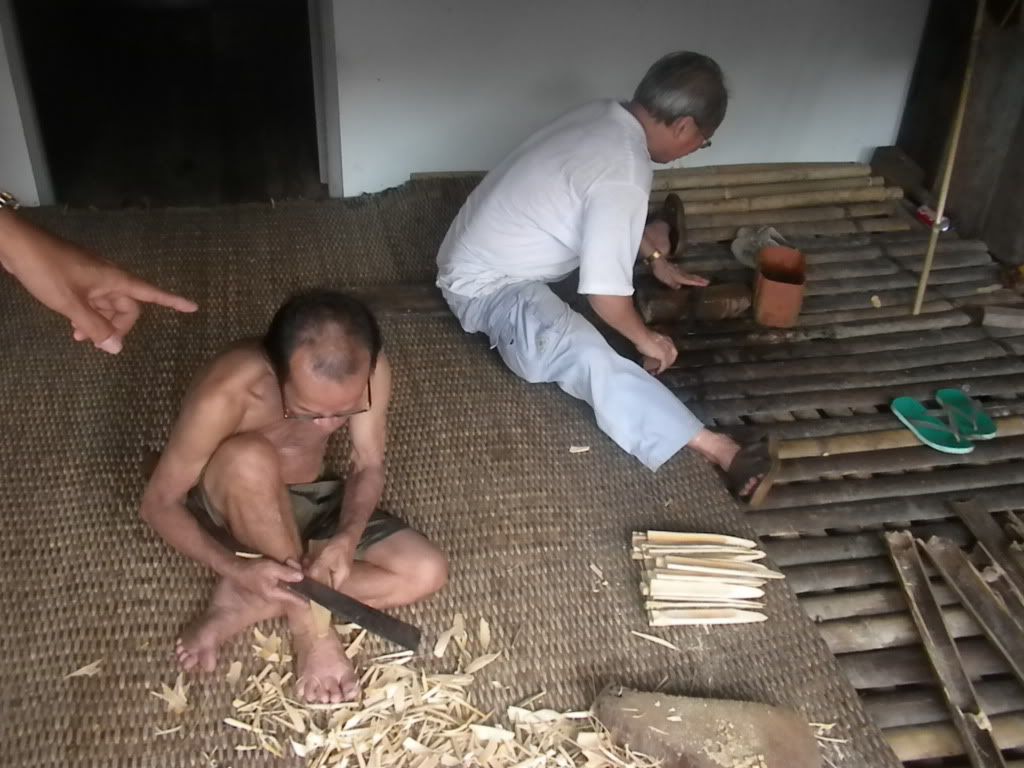

He told us it was still a little dangerous to go trekking, due to all the rain. Later on, it would be okay to go out. However, the track would be slippery and still quite difficult. He offered for us to eat lunch first, and then decide what to do. Francesca already looked uncomfortable with the idea, so we decided that I would go whilst she rested up. Around 1 PM our first meal was served, and boy, were we in for a treat! We got bamboo chicken, a very simple but extremely tasty chicken broth. The herbs used all come from the rainforest and the chicken is killed the morning of consumption. Along with the chicken came a plate of beans and one with local fern. The chicken was so tender and tasty; I swore I never ate a better meal in my life!

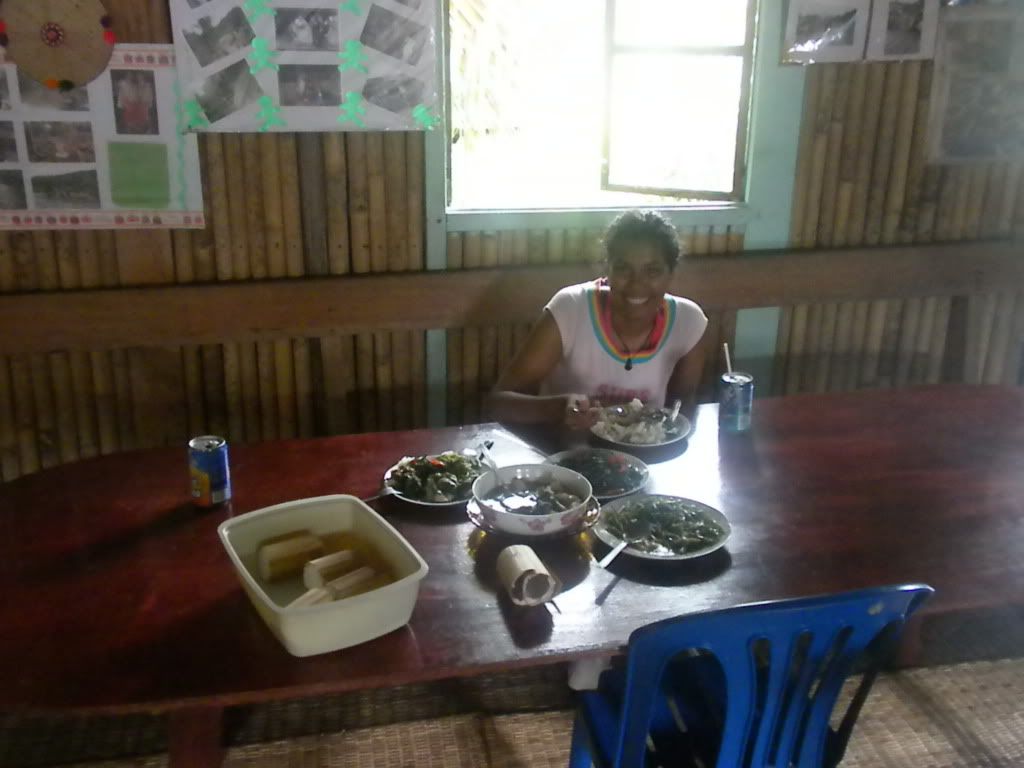
Uncle Edward told me I should go hiking soon, because he was expecting more rain. His nephew Sebastian would take me for a walk, and I had to be ready around 1:40 PM. I grabbed a bottle of water and a poncho and joined Sebastian. Sebastian barely spoke any English (less English than I speak Bahasa, go figure!) so I knew the hike would be quiet. Within the first meters I saw how the coming hours would be: wet, slippery bamboo and makeshift bamboo bridges. Not too comfortable! Furthermore, Sebastian raced off whilst I tried to take some pictures of the surroundings. He stopped here and there, muttering some words in English about the plants I pointed at. Half of it I could not understand, but I gathered I was looking at local herbs like wild ginger.
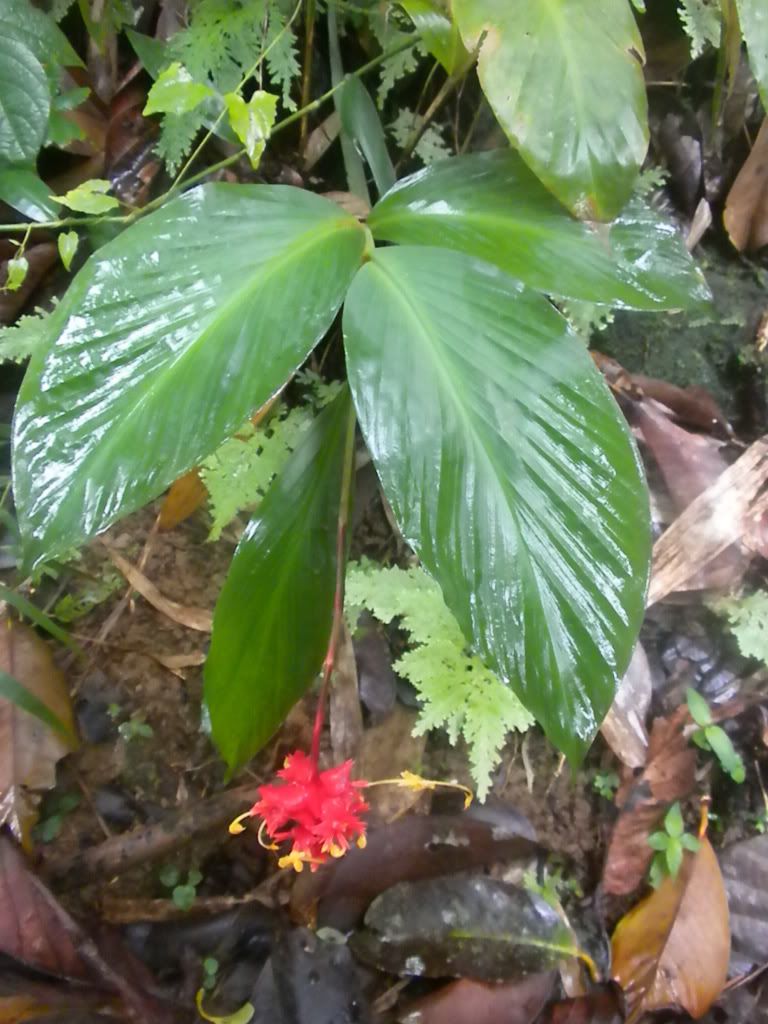
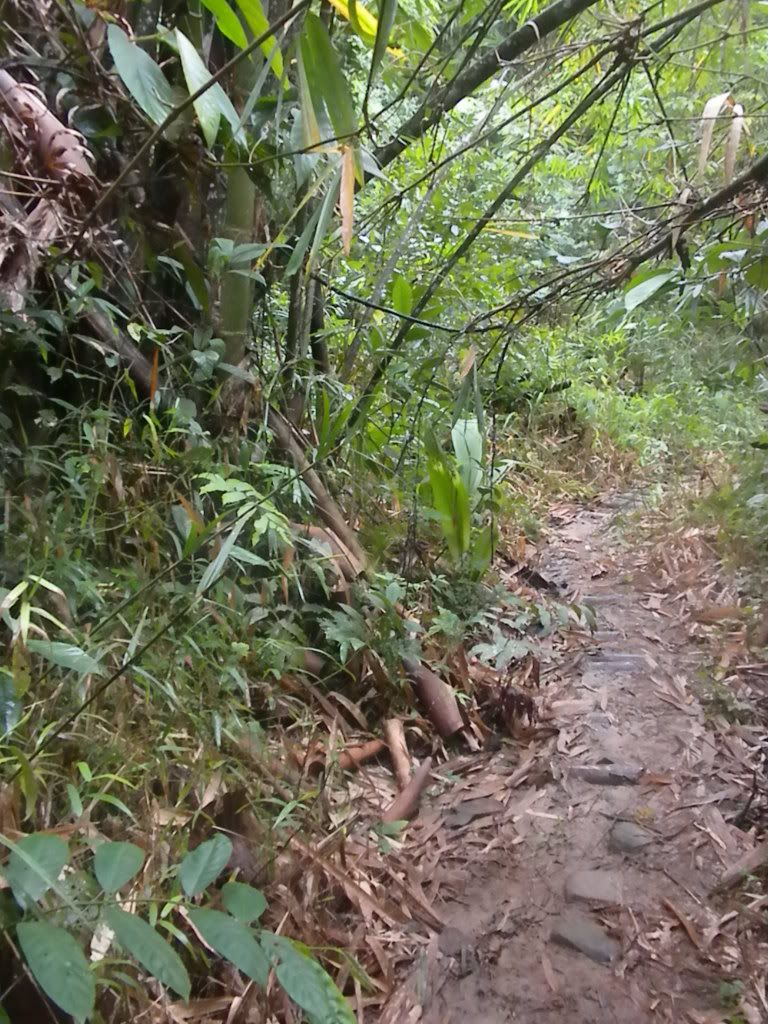
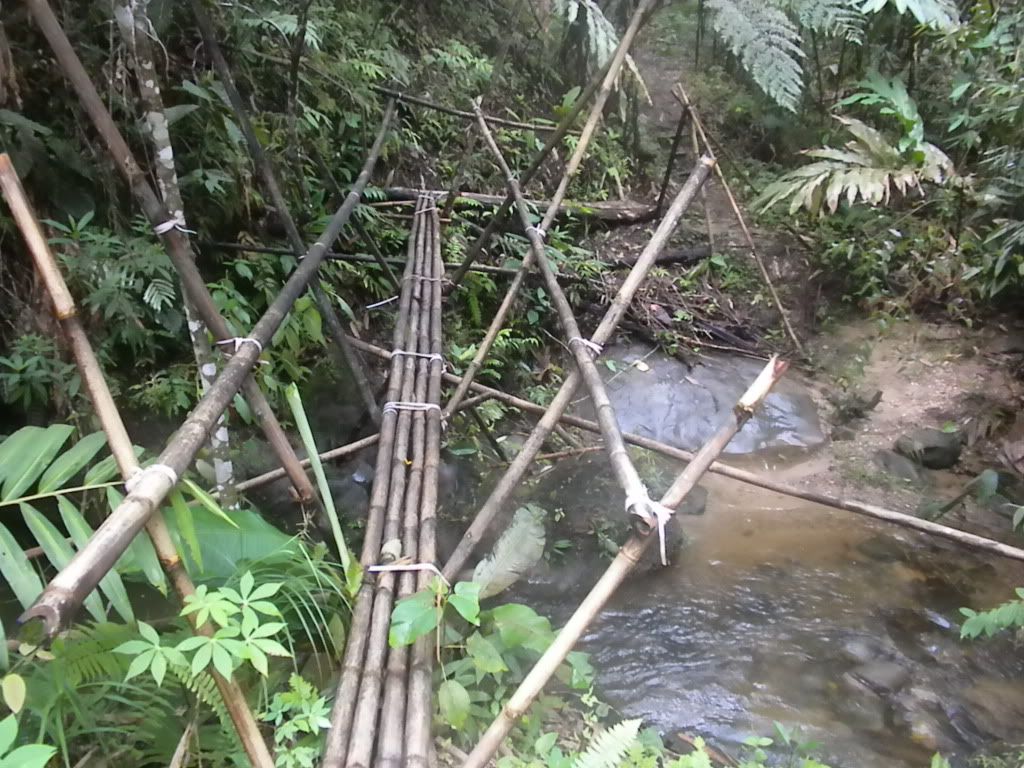
The first 45 minutes went straight uphill and it seemed Sebastian was constantly racing ahead. I managed to keep up, but was soon covered in sweat from head to toe. We passed some rice paddies and were passed by an herb collector, who was on the hunt for wild ginger and other local spices. Sebastian carried a machete because the trail wasn’t used that often, so he could chop away any new growth. Around 2:30 PM we reached the end of the first part of the walk. The next section was on the main road through the countryside and was pretty steep. I knew we’d have a blast going back up later that afternoon!
15 minutes later we got off the road again and back into the rainforest. We walked along a river, sometimes on bamboo bridges overhanging the river. I slipped once and had to remind myself I didn’t want to go swimming in this river… Uncle Edward had told me the river tends to be clear, unless there’s too much rain, which makes it carry more sand and, more worrisome, trunks. Around 2:50 PM we passed through some cultivated rice and pumpkin fields. Mosquitoes were plentiful and since the bug repellent had long since been sweated away I was left fending for myself. The buggers got to me several times.
By 3 PM sharp we made it to the waterfall and that made it all worth it! I guesstimate the waterfall is about 50 meters high, because Uncle Edward couldn’t tell me if anyone had ever measured it exactly. It came flowing down in three layers and the thunder was a little deafening. I took my shoes off to step in the refreshingly cool water and climbed up a few rocks to have my picture taken. I washed my face and arms in the water and immediately felt better. 15 minutes later I had seen enough and decided to start our march back to the village. Climbing the road proved to be quite a challenge and my companion actually had a hard time keeping up with me!
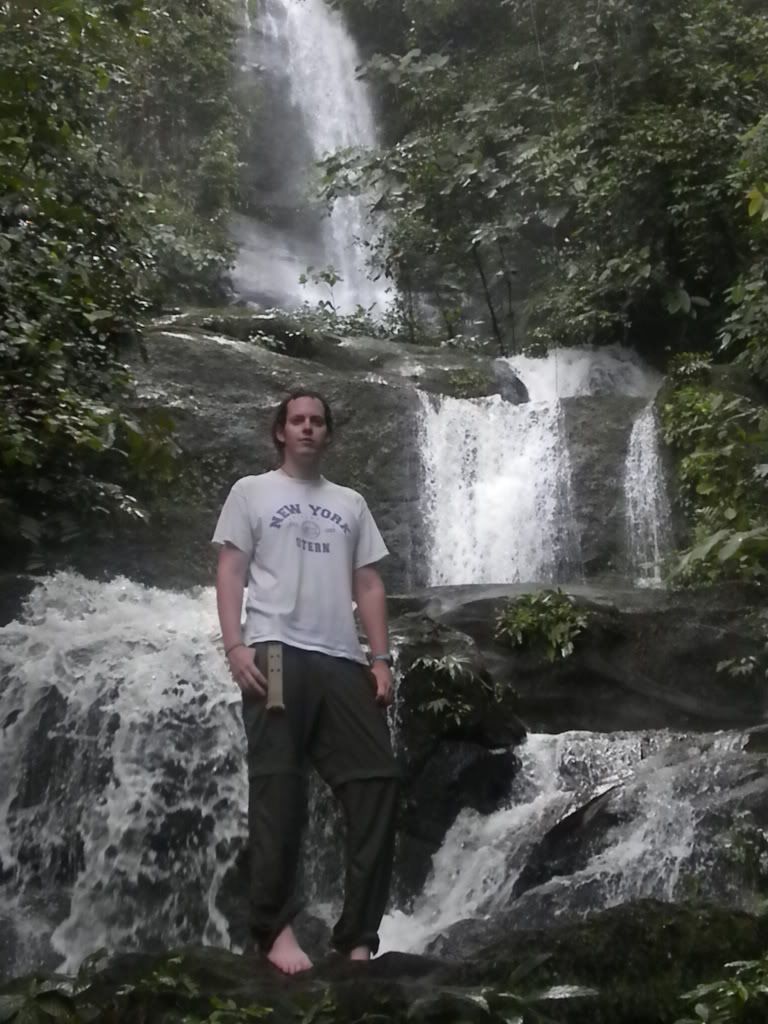
We pretty much raced through the rest of it, trying to escape the ominous gray clouds overhead. Uncle Edward was surprised to see me back after just 3 hours; we had made it back in record time! He was still sitting at his table, joined by Francesca, whom was talking to him. He said I’d better have a shower quick snap, because we were about to be guided through the village. I had a quick (and cold) shower and got dressed. Well, dressed partially, because I hadn’t brought a clean shirt. Luckily we could borrow a shirt and I was good to go. Uncle Edward took us to some of the more traditional houses, explaining they had been abandoned in favor of stronger, more modern versions. We saw how a large family lived in a completely open communal space, and how they store their rice on the ‘ceiling’ in large round basins. I climbed up the wooden beam and had a look, finding it hard to see and even harder to get down the thin ladder.

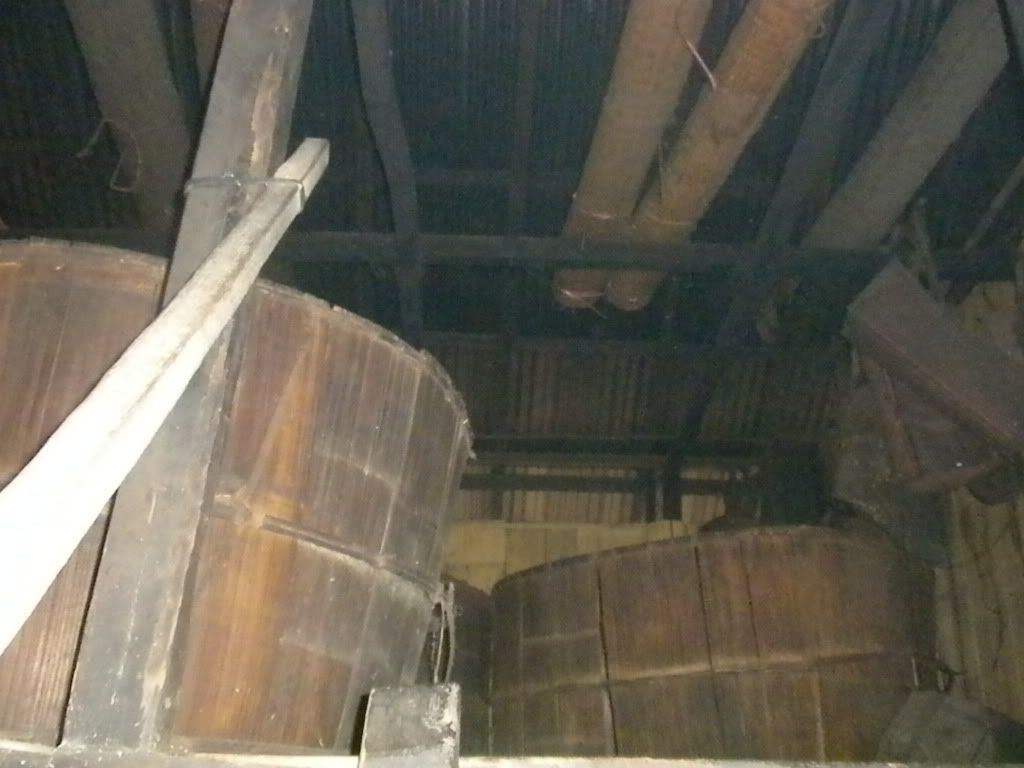
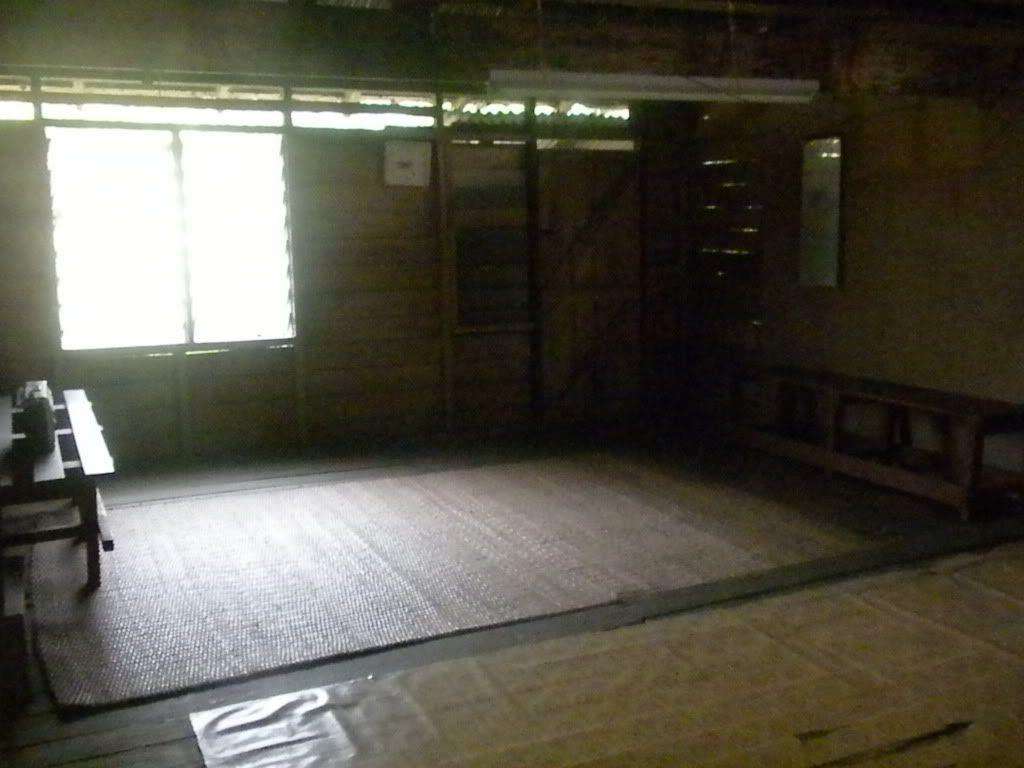
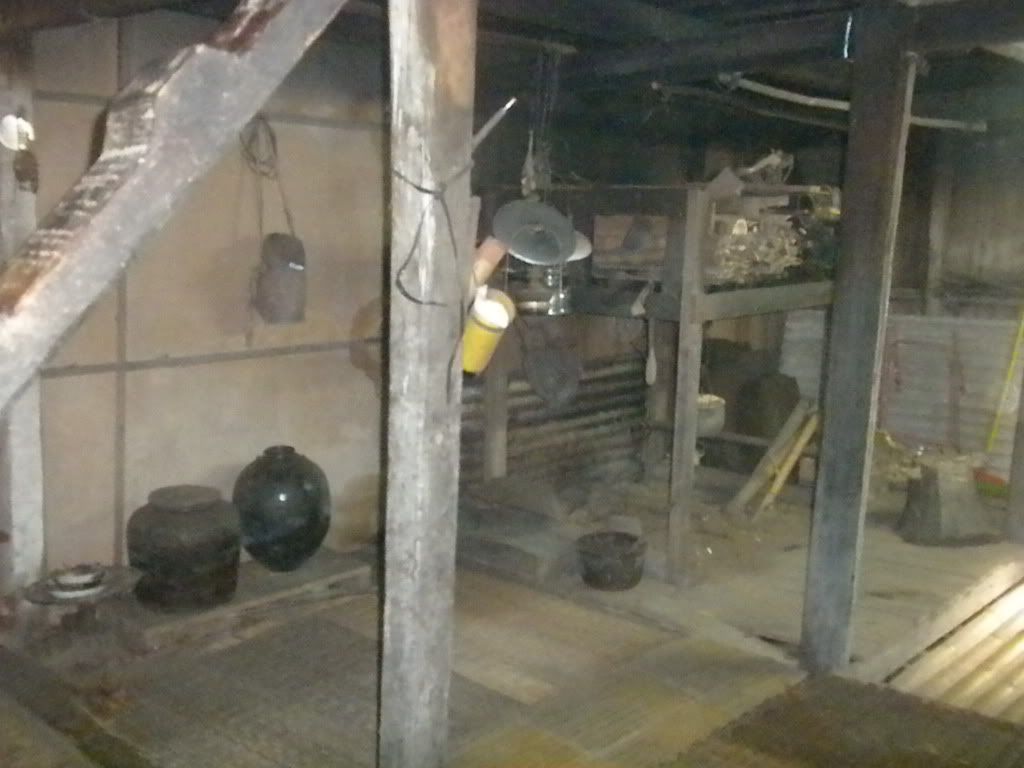
Next, Uncle Edward took us over the bridge across the river, showing us the monkey-tail fern we had eaten earlier that day, as well as wild rambutan, local cocoa, jackfruit and other fruits and herbs. He also showed us their sugarcane crusher: an ingenious contraption, made with one heavy log with other smaller logs tied around it unevenly. Moving the big log would cause friction, and due to the uneven weight it was pretty easy to keep the log going.
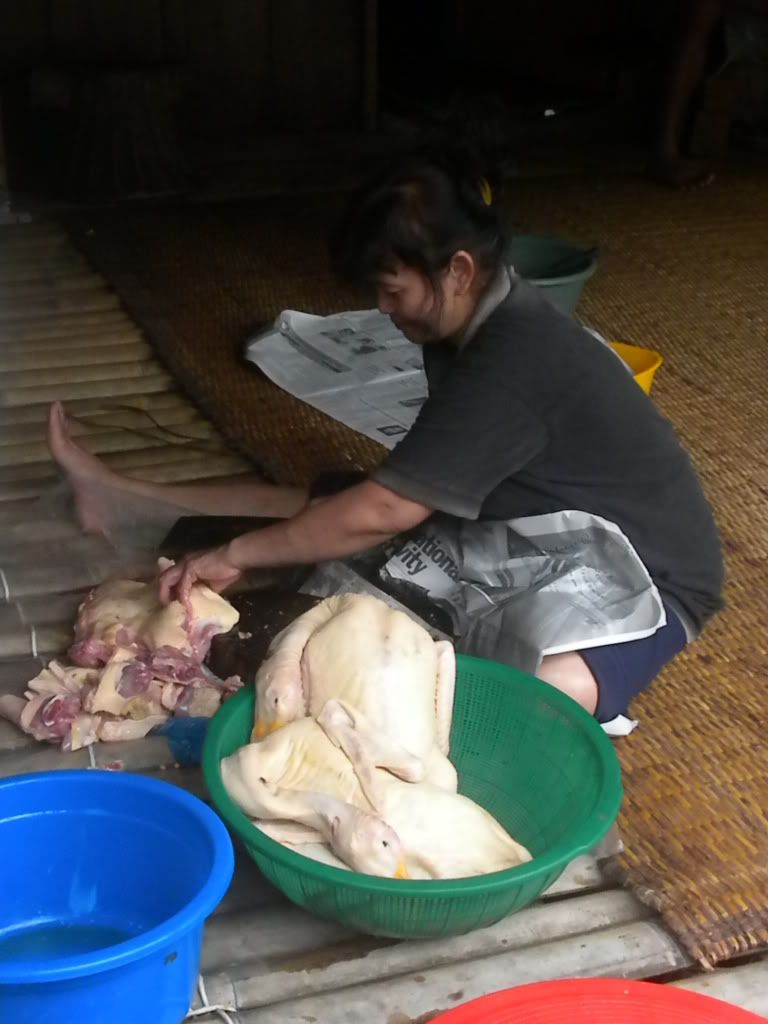
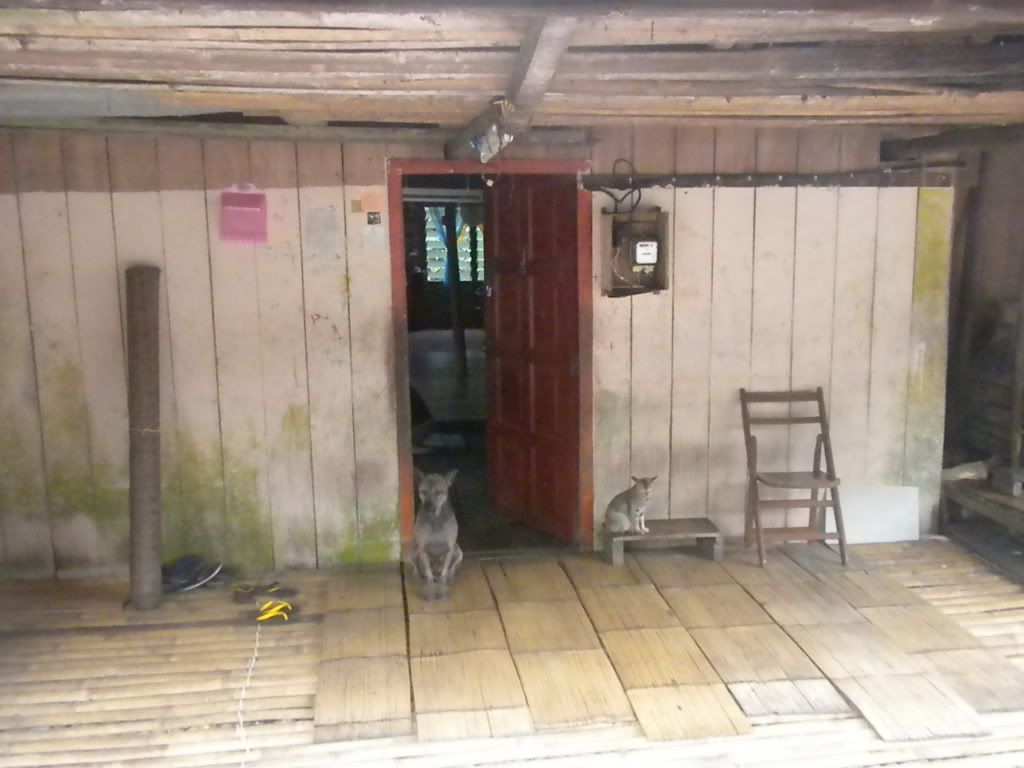
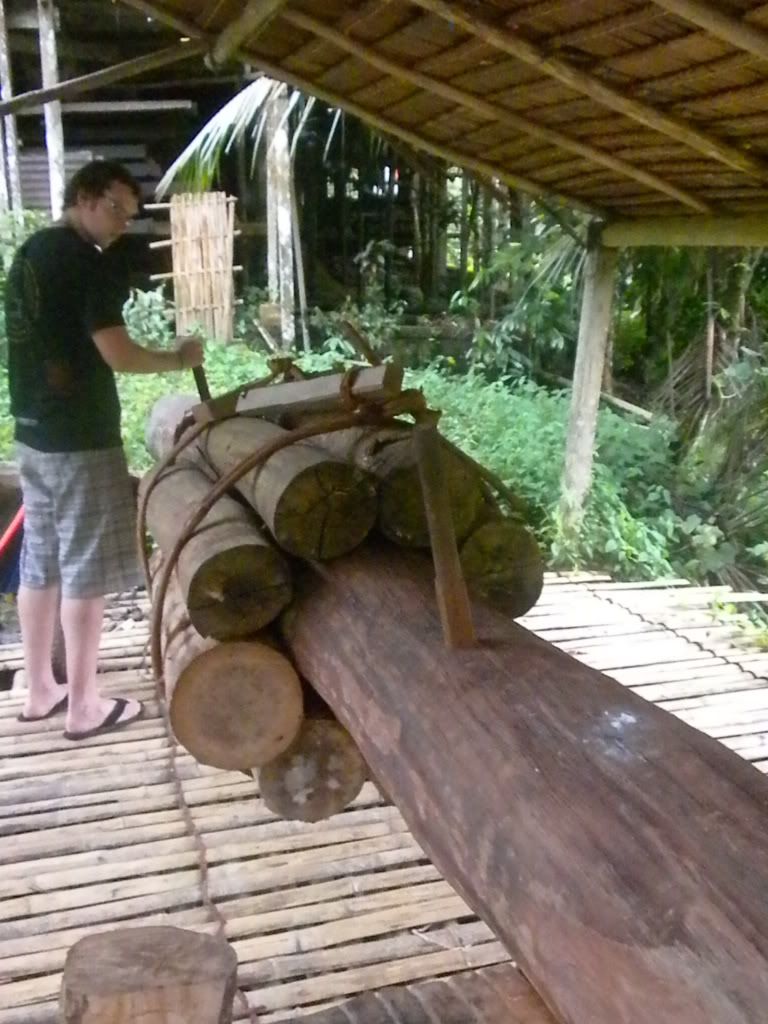
Francesca and I also got to have a look at the ‘skull room.’ Even though the Bidayuh were a peace loving people, others wanted what they had. They had to defend themselves. They took no pride in killing, but would honor the dead leader(s) of their enemy by severing the head and bringing the skull back. We saw a collection of about 10 skulls in a basket above a fire, used during important ceremonies. The skills dated from the 15th century according to Uncle Edward. Francesca and I agreed we should have felt a little weirded out by the human skulls, but we were actually very intrigued. The ‘skull room’ was also the home of an old Dutch cannon. Uncle Edward couldn’t tell us exactly how his tribe had gotten this artifact, but I promised him I’d do some research for him. The cannon is inscribed with ‘PIETER SEEST – ANNO 1756.’ I found out that Pieter Seest made the cannon, but can’t find records of ships that would’ve stranded in the region. Help me out if you have some spare time and you like cannons!
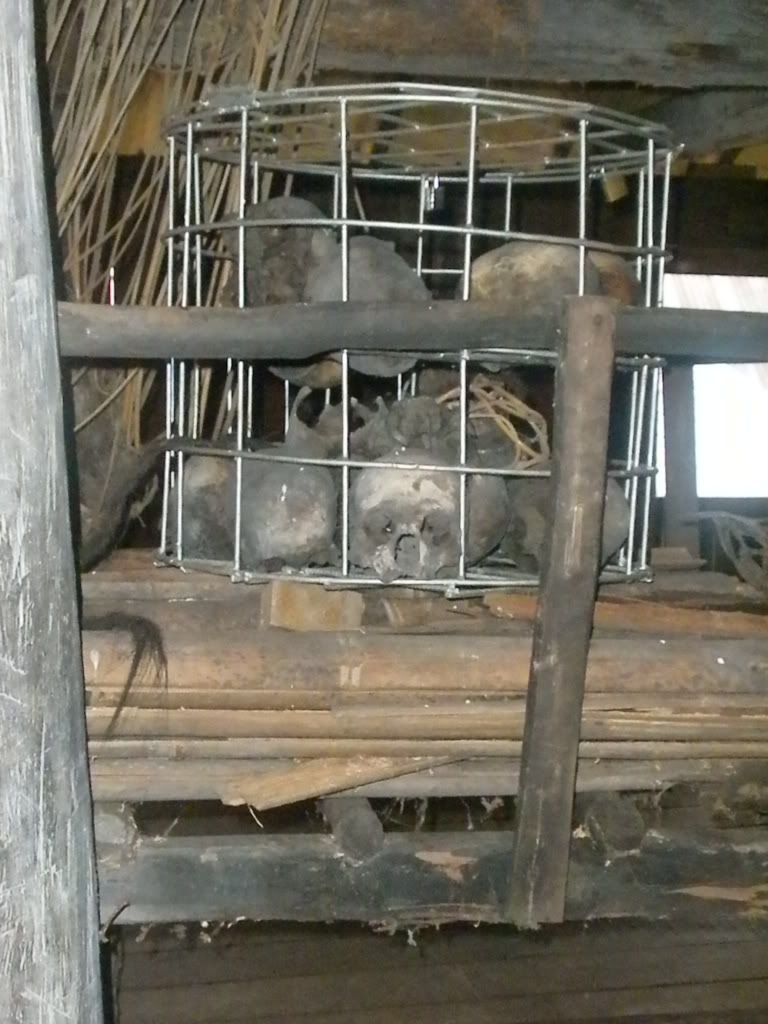
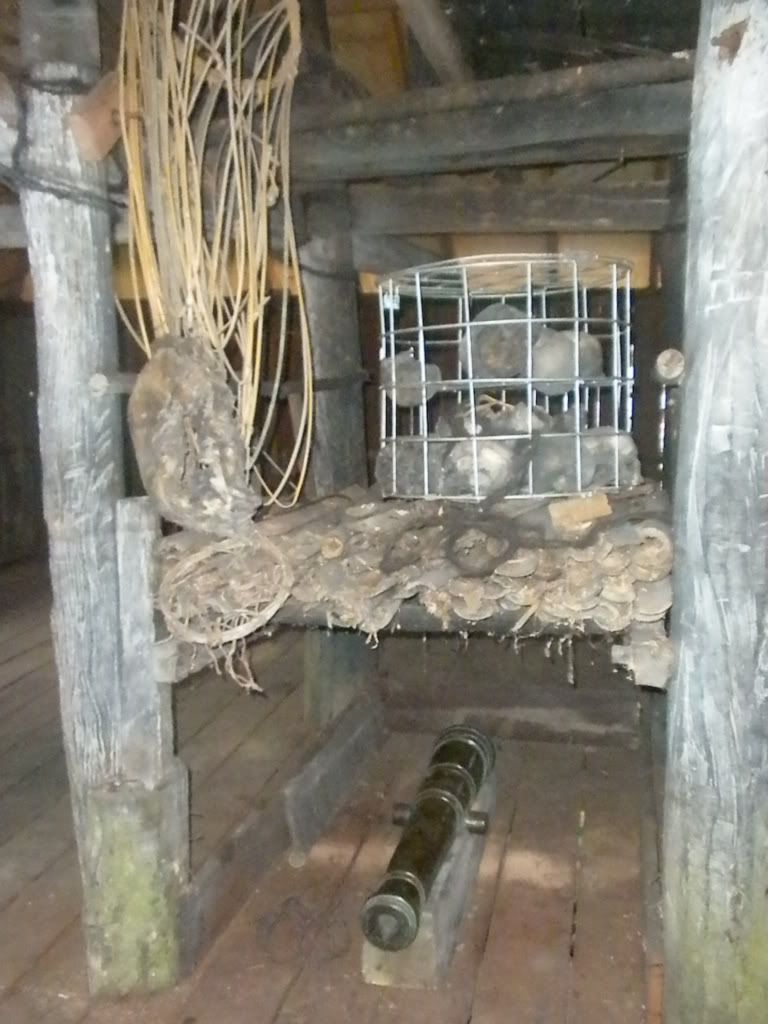
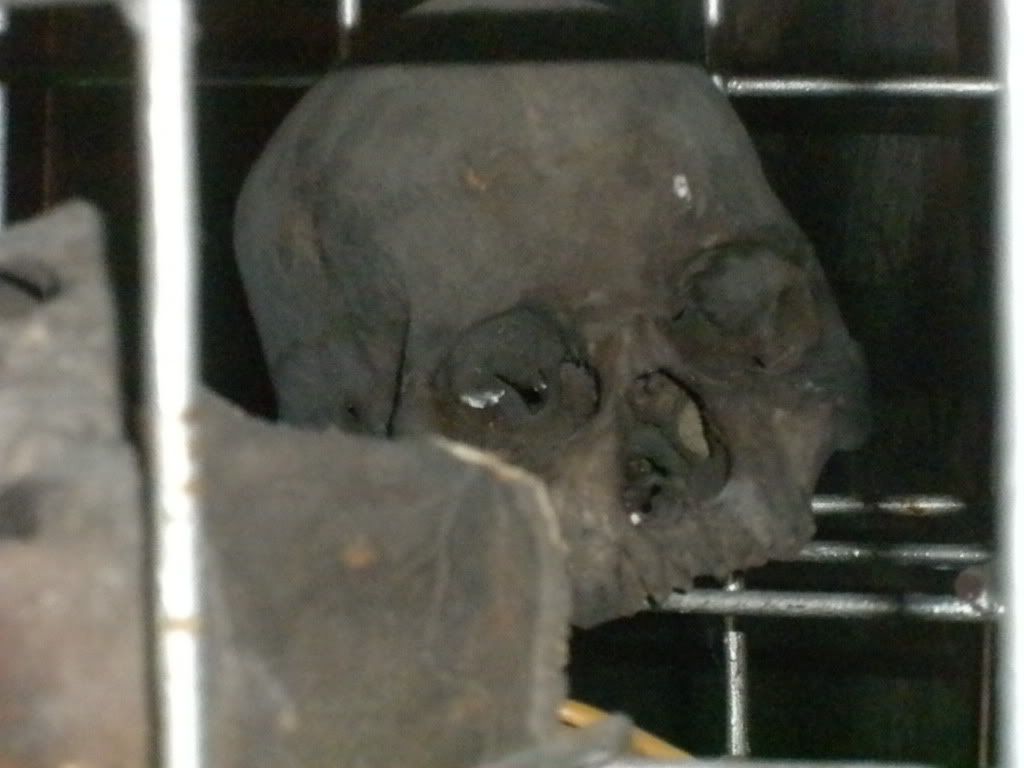
We also met some of the kids as we were walking through the village. I found a little friend, and Francesca took pictures of me! We also saw – what I presume was chicken – roasting on the fire. Yum! Uncle Edward showed us some of the cocoa I talked about earlier. They make their own chocolate drinks with it! After the tour we sat down and got ready for dinner. I was starving after all the walking of the day, as well as very excited about what food might come our way this time. I wasn’t left disappointed as the table filled up with another tasty chicken and mushroom dish, more of the green beans and another chicken salad. Whilst it didn’t beat the bamboo chicken, this meal was nearly as heavenly. Uncle Edward also forced me to drink more ‘tuak,’ this time letting me try the 30% homebrew. Since I’ve not been drinking for a while it was a little much for me! I went back to the ‘girly tuak’ which was a little sweeter. For dessert we got to try rambutan -- very reminiscent of mangosteen, just a little different in shape.
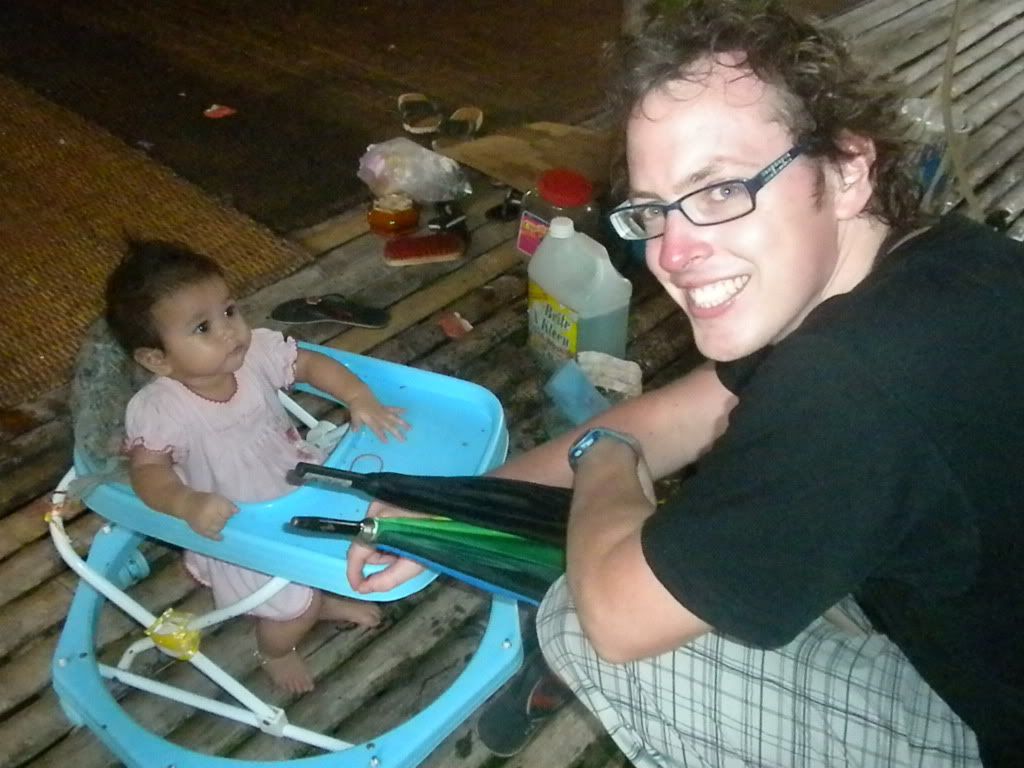

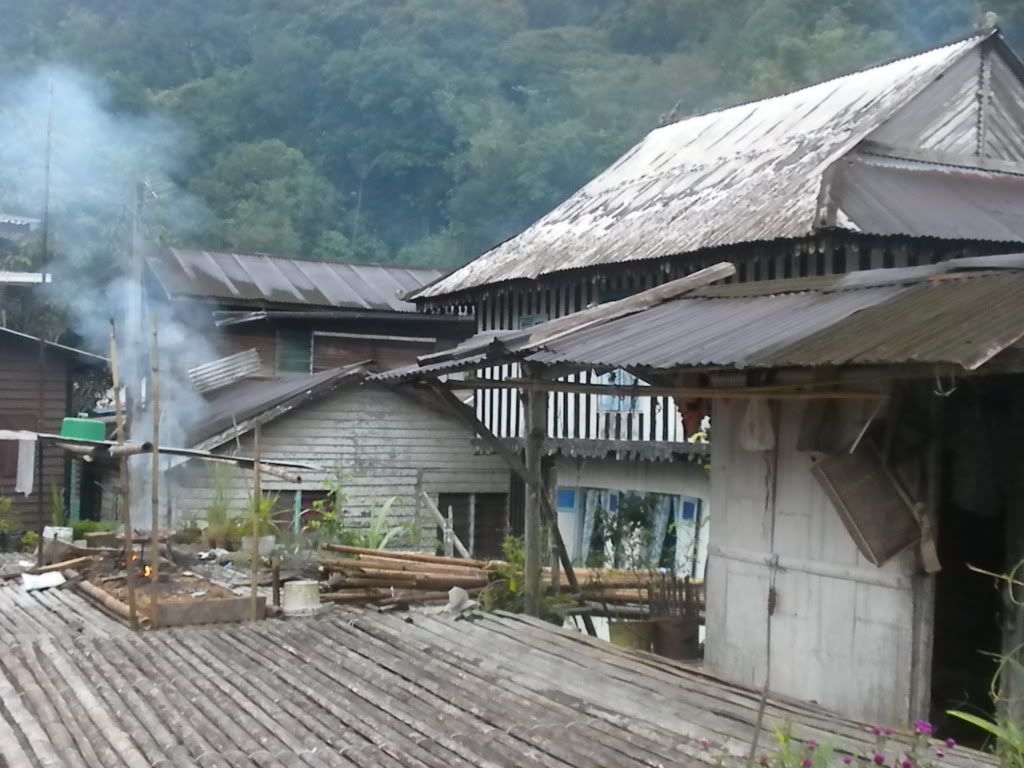
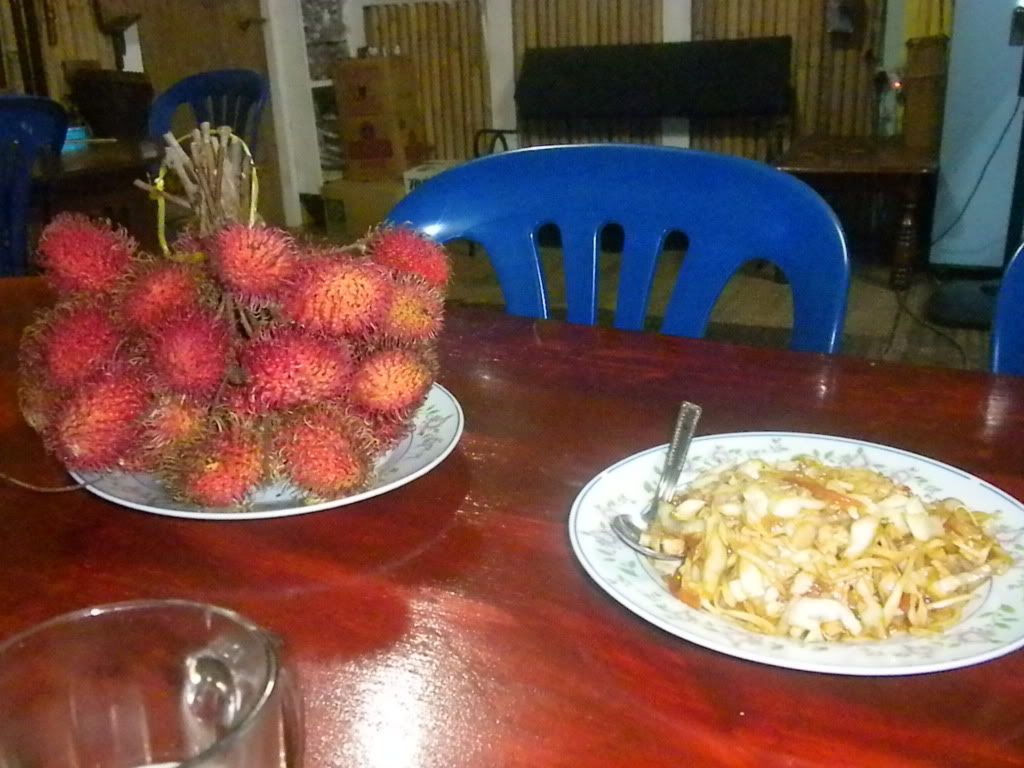
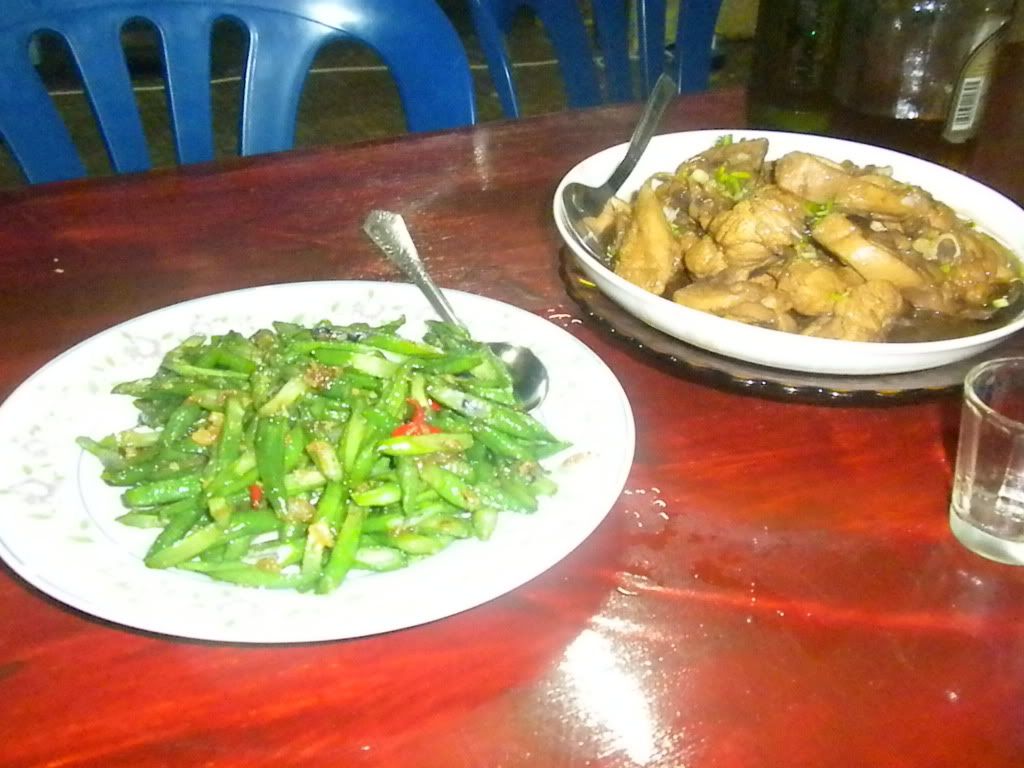
After dinner Uncle Edward sat down with us to share some stories about his people. He told us about the weapons they used and let us try some of them. The blowpipe was their main weapon and Uncle E. shared that it takes over a year to make a perfect blowpipe. We got to shoot at a dartboard and showed immaculate aim! Next, he let us have a look at family heirloom: an old sword that had once been used to kill people. The design of the handle was extremely detailed and told a story of animals. Uncle Edward then had us guess what a bucket with shoulder straps was for. We thought it was used for food, but he quickly smiled and added it had been used to carry heads.
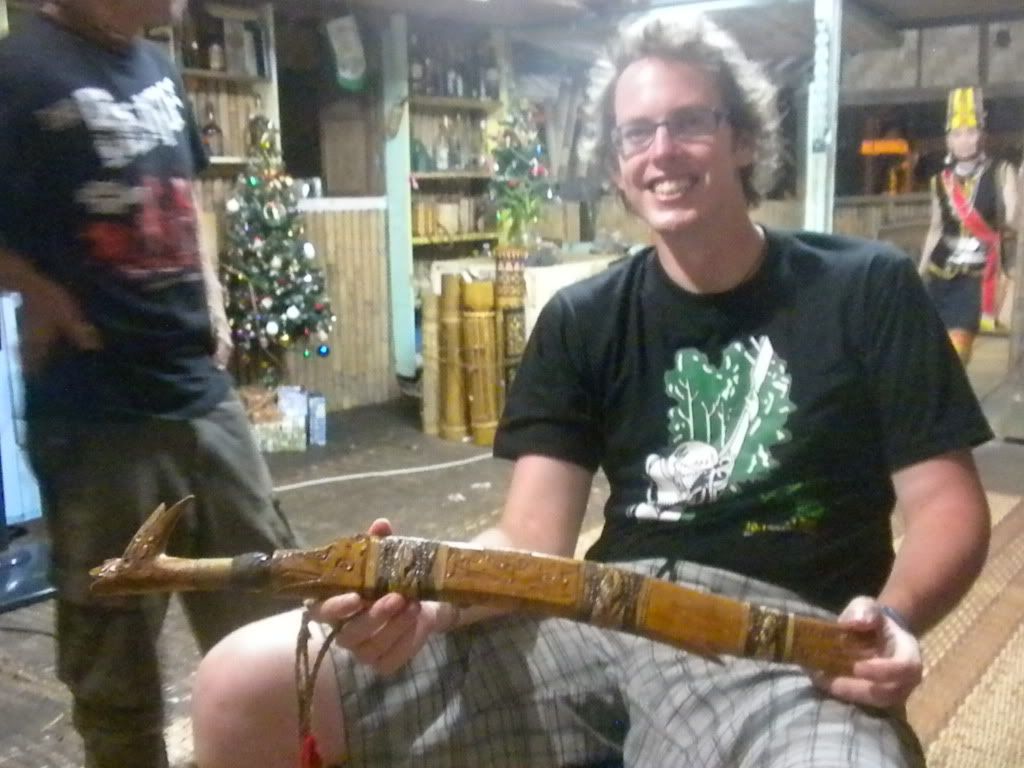
There were also several larger ‘backpacks’ on the walls. As we had previously guessed, these were indeed used for carrying rice. Uncle Edward said some of the larger once could hold up to 100 kg of rice, and were often carried by women. Sometimes they even stacked a second, smaller bucket on top of the big one. To be able to support the heavy load the women’s legs, arms and neck were covered in springs to divide the weight more. Lastly, Uncle Edward showed us a harpoon gun, asking us how far we thought it could shoot the little harpoon. He had us inspect the gun and then had me hold out an stick, which he would Wilhelm Tell out of my hand. I had faith in his skills, but as he got ready to shoot he started laughing. The harpoon never even left the gun! It was held back by some rubber bands, because it was only used to fish; no need to lose your harpoon over that!
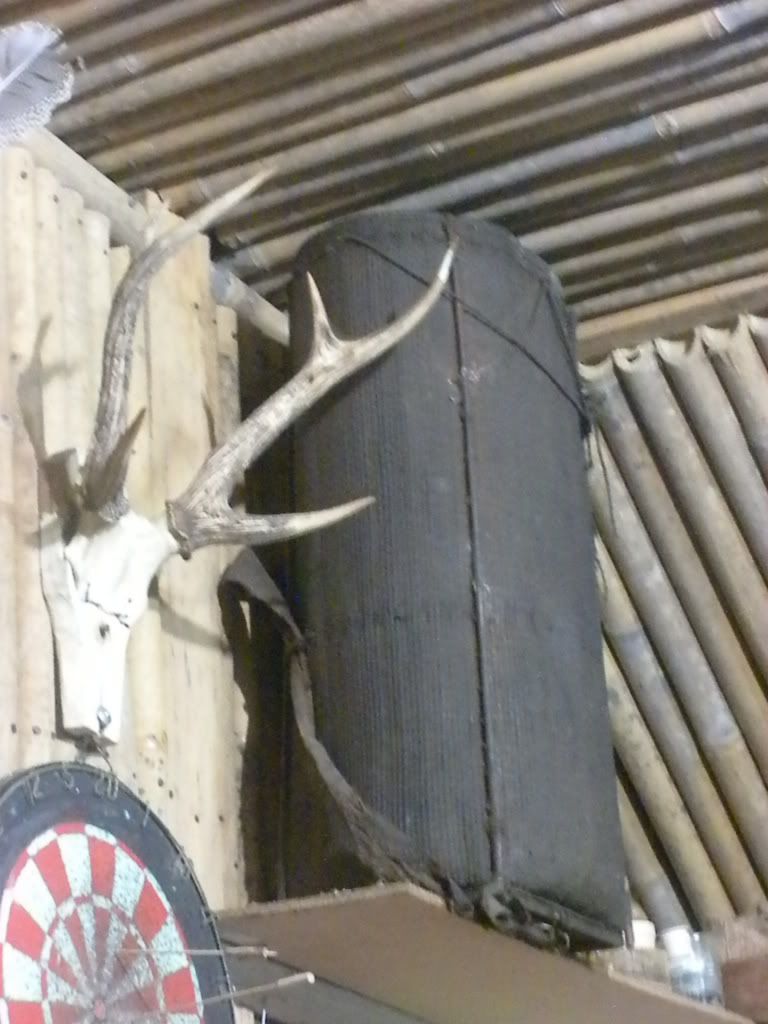

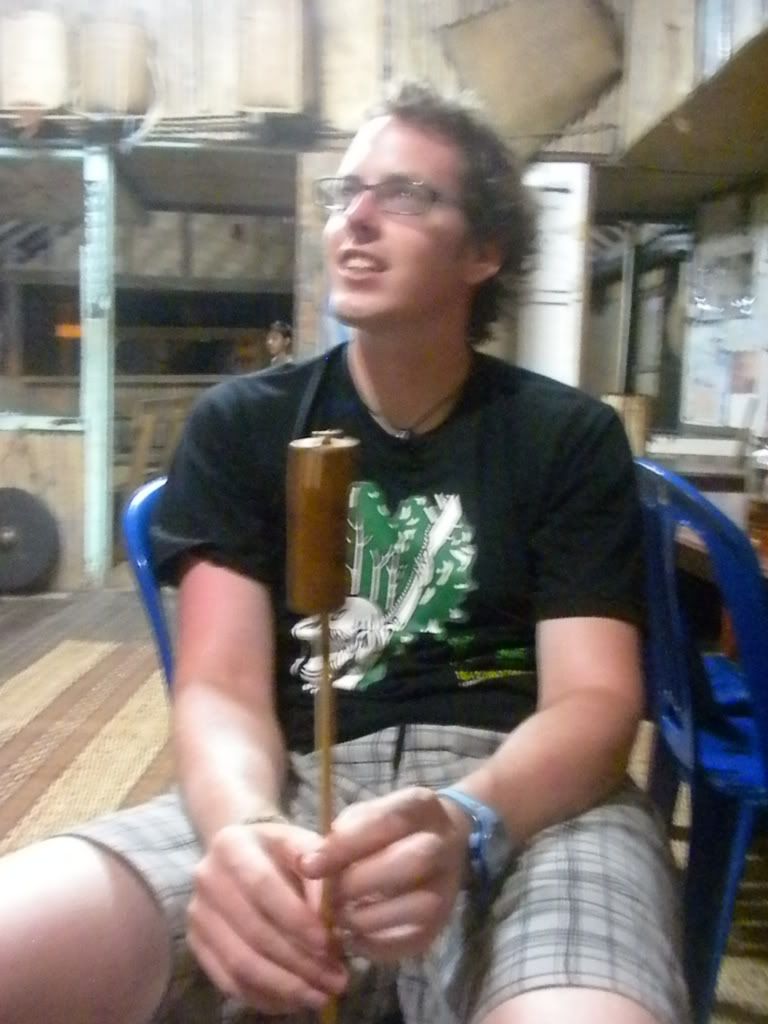
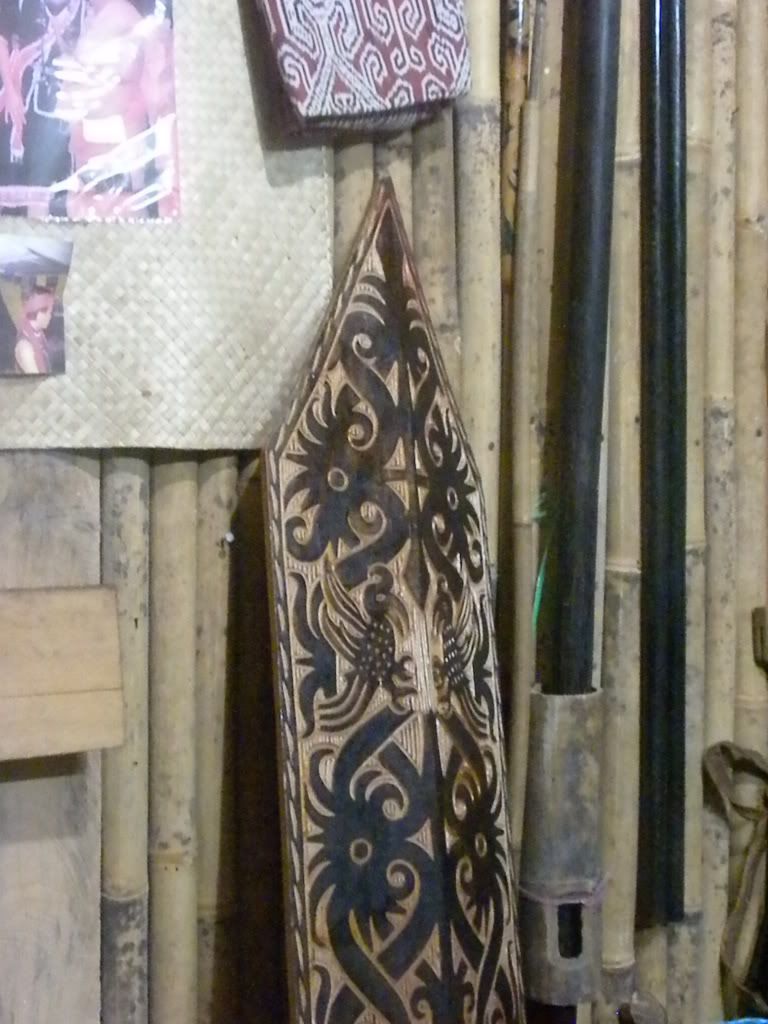
The evening wasn’t quite over! Francesca and I had asked to see a ‘cultural show’ and Uncle Edward had arranged for it. The men were out of town to get ready for Christmas, but an old lady was still there and she performed several dances for us. Francesca was asked to join and got dressed in a traditional outfit. She looked very local! The old lady asked her to follow her lead. First, she did a welcome dance, followed by a return-of-the-warriors dance, where she had to reenact a bird. The old lady then did some dances by herself. I was asked to join the final dance, and light as a feather we flew off and the show ended.

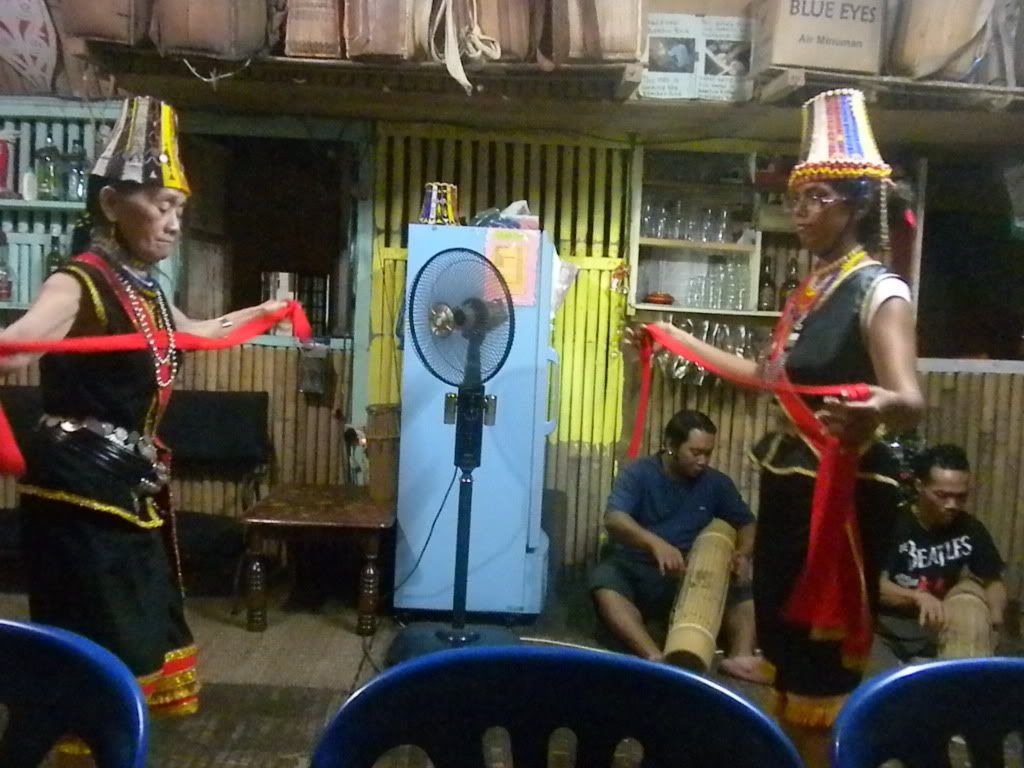
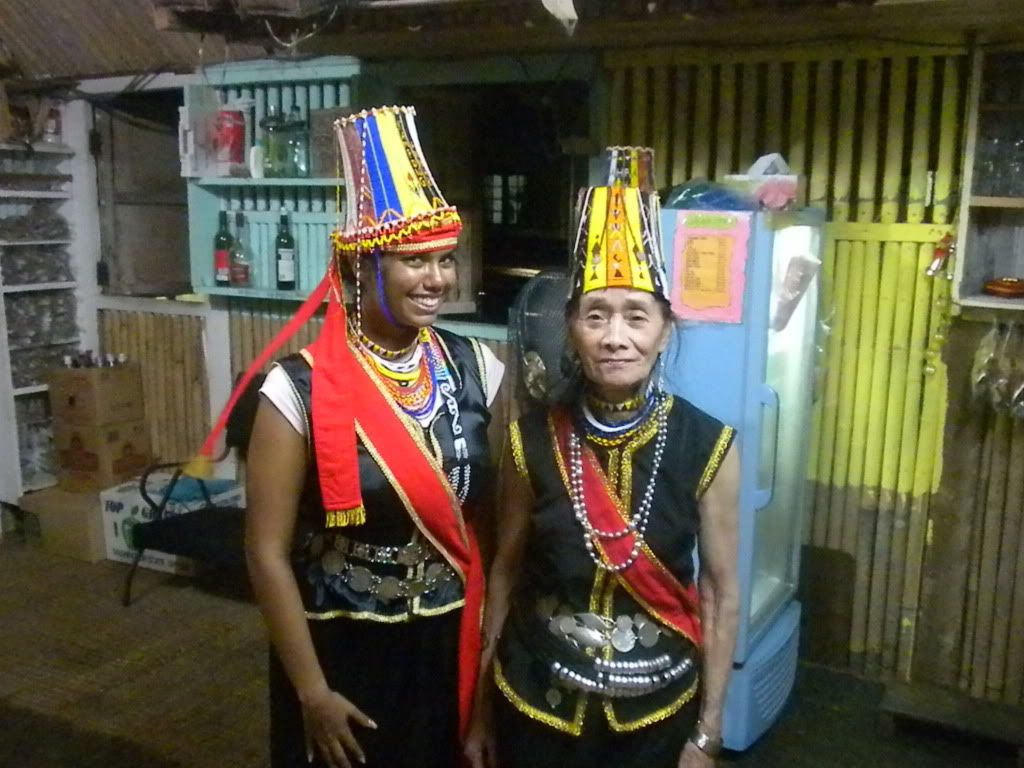
After dinner Francesca and I had one more thing planned: there’d be a mass at midnight with all the villagers. There’d be a walk to the church a little earlier and we wanted to go. To kill the time Uncle Edward invited two guys over, both Malaysian. The younger man worked for Shell Oil, and the older man, his uncle, was a lawyer. We had a very animated conversation with them, discussing world politics, sports, South-East Asian culture, economics and history. Before we knew it, it was almost midnight. We asked Uncle Edward when we would leave, but he told us the mass had been moved to 6 PM and they hadn’t told him. We missed our mass, but got a great conversation in return. When the two men got ready to get some sleep we did the same. Around midnight Uncle Edward’s son had come over from Kuching to spend Christmas and he was making some BBQ chicken. I devoured one piece and went upstairs to Francesca to get some sleep.
The next morning we got up around 9AM and breakfast was served 30 minutes later. This time there was beef on the menu. Francesca described the sauce as “perfectly spicy” and absolutely loved it. We also got a chicken curry and more rice. Amazing food -- still makes my mouth water thinking about it. Unfortunately, breakfast meant the end of our stay with our new Uncle. It was sad to say goodbye. Sam and Jun Ho came up to visit some of their friends and Sam took a picture for us with Uncle Edward. We walked around the village, visiting their friends and getting another drink. We learned how to decline offers, as we were offered several gifts. A nice way to say ‘no’ is touching the gift, and putting that hand on your heart. It says you accept the gift in your heart, but decline the actual gift. Very clever!
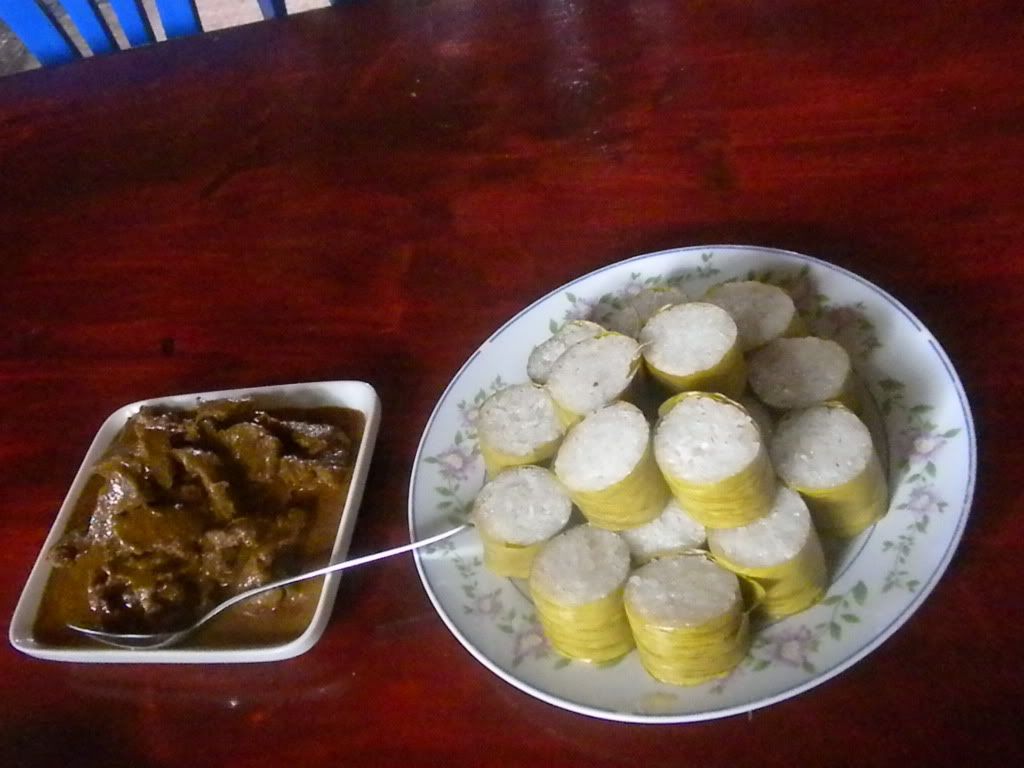
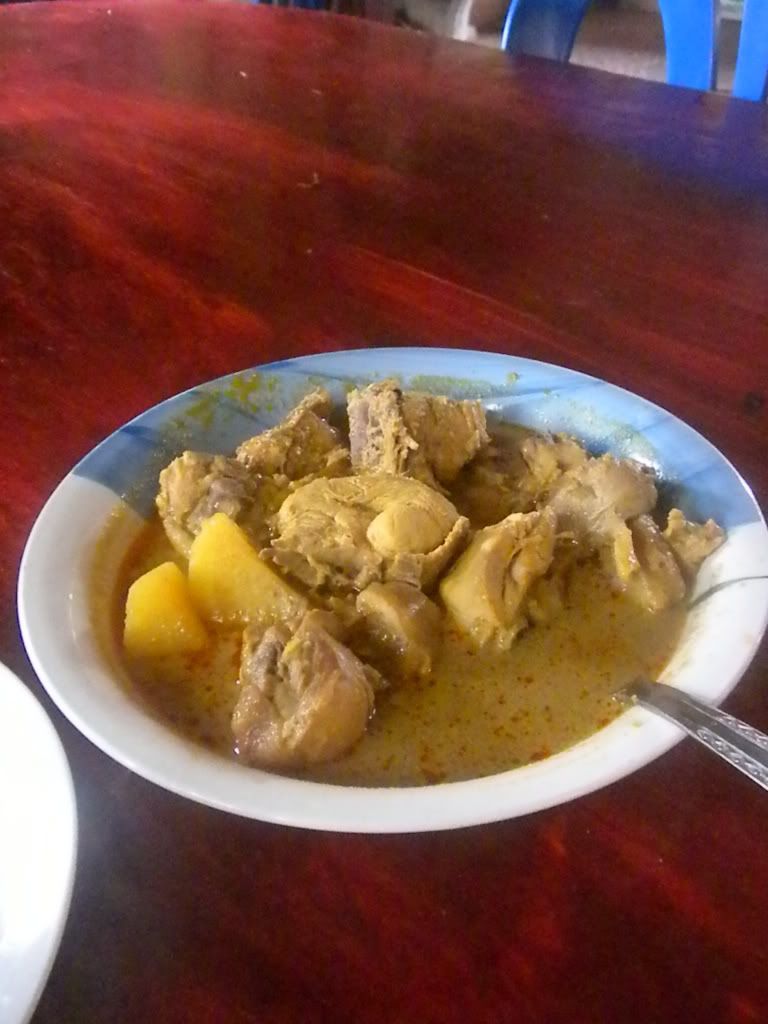
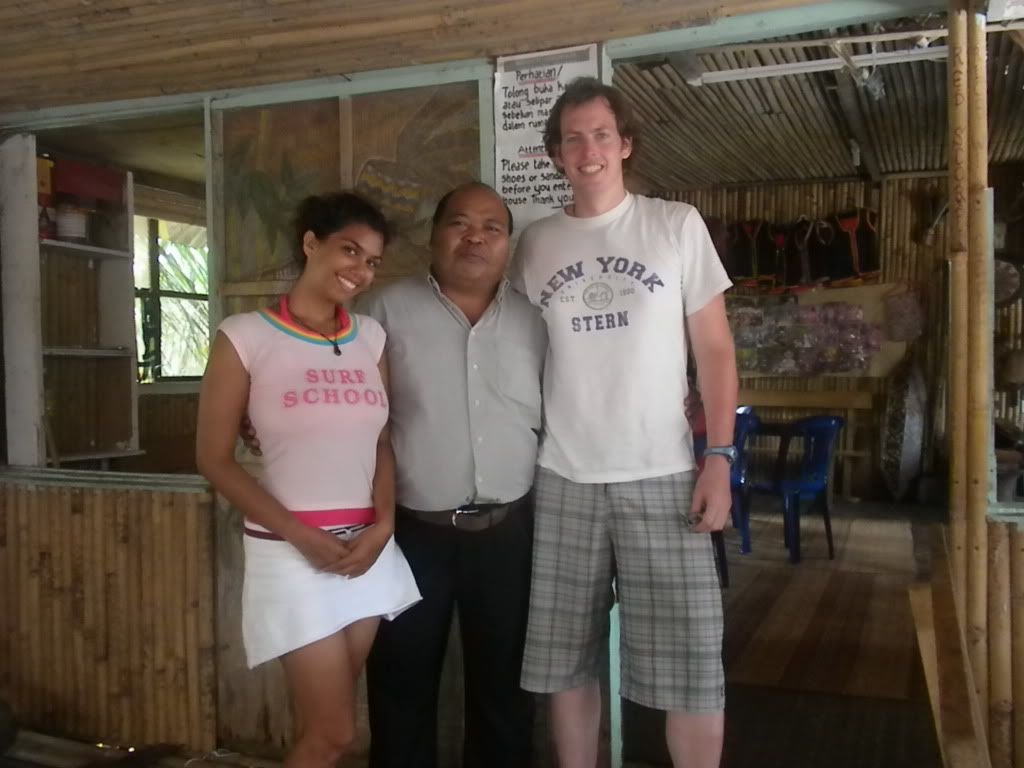
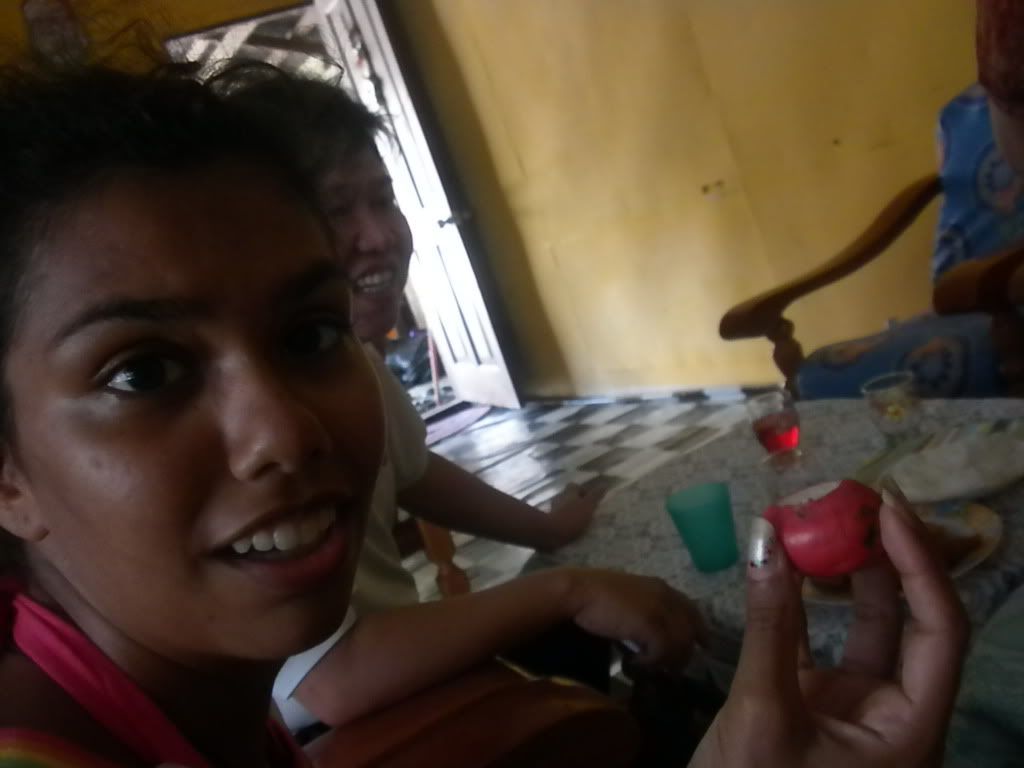
Sam and Jun Ho dropped us off at Tracks and we said our goodbyes and thanks to them. They’d certainly been the right people to book our tours with! Francesca and I crawled in bed as we rested up. I went out in the afternoon to book us a table for a Christmas dinner. Francesca had no idea where we were going to go, but I had found the perfect place! Around 7:30PM we left and I took Francesca to ‘The Junk.’ To explain, ‘junk’ does not mean ‘garbage’ in this case; it’s a Chinese sailboat. The place was decorated with rambutan (being red and green, pretty good for Christmas!) and the style was eclectic. We sat down and Francesca ordered the Turkey Roast dinner and I went for the Salmon. The plates we got were enormous and the food was absolutely delicious. We both got a huge salad and mashed potatoes with our large piece of protein. All in all a very successful Christmas!

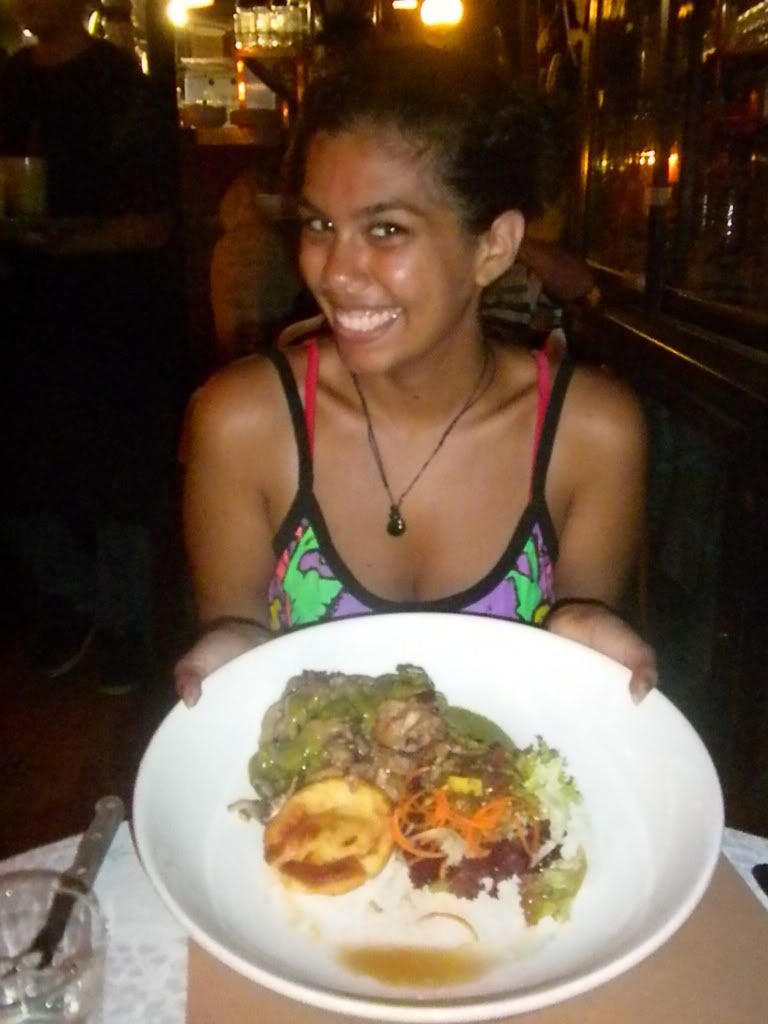
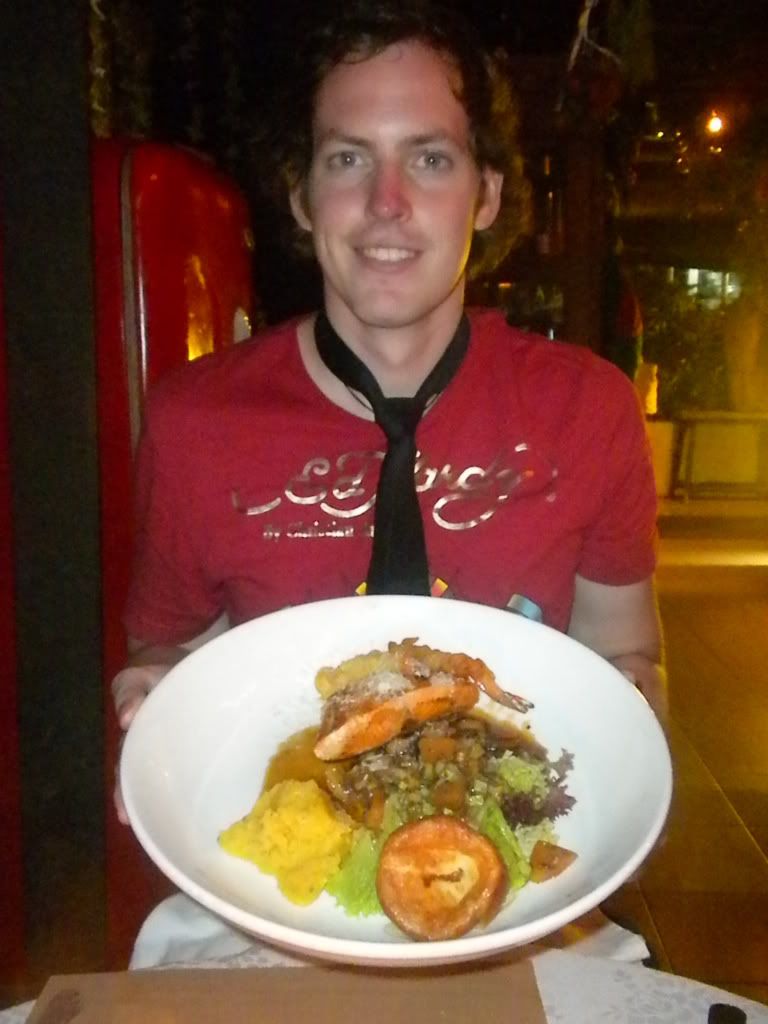
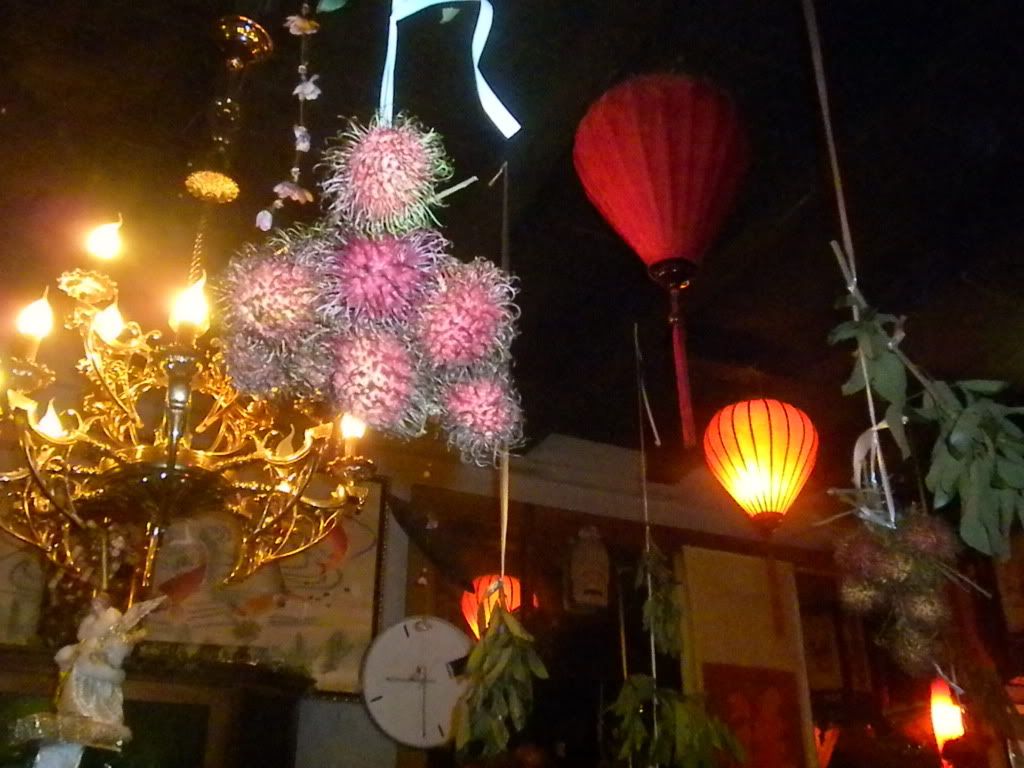
Francesca will tell you all about our final days in Kuching!
